Napoleon HD46NT-1, HD35NT-1, HD35PT-1, HD40PT-1, HD46PT-1 User Manual
...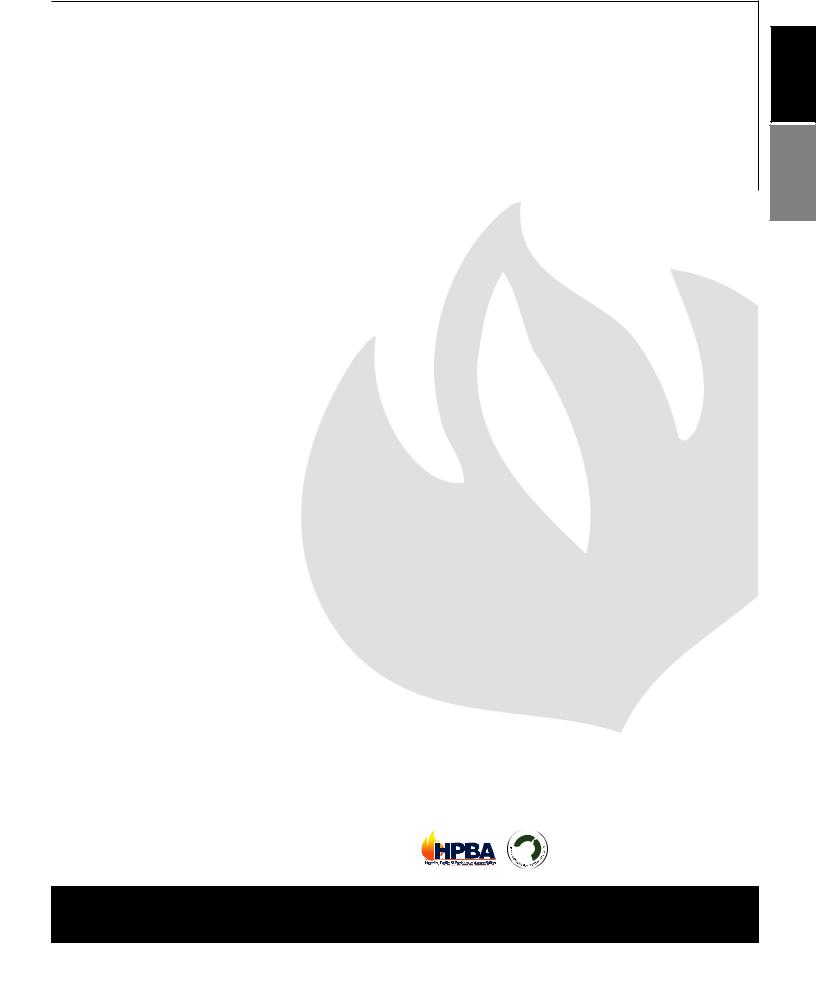
INSTALLER: LEAVE THIS MANUAL WITH THE APPLIANCE.
CONSUMER: RETAIN THIS MANUAL FOR FUTURE REFERENCE.
NEVER LEAVE CHILDREN OR OTHER AT RISK INDIVIDUALS ALONE WITH THE APPLIANCE.
|
INSTALLATION AND |
|||
|
OPERATING INSTRUCTIONS |
|||
|
|
|
|
|
|
|
|
|
|
|
|
|
|
|
|
CERTIFIED TO CANADIAN AND AMERICAN NATIONAL STANDARDS: CSA 2.22 AND ANSI Z21.50 FOR VENTED GAS FIREPLACES. |
|||
CERTIFIED FOR CANADAAND UNITED STATES USING ANSI/CSA METHODS. |
HD35NT-1, HD40NT-1 & HD46NT-1 |
|||
|
SAFETY INFORMATION |
|
NATURAL GAS |
|
|
|
HD35PT-1, HD40PT-1 & HD46PT-1 |
||
|
! WARNING |
|
||
|
|
PROPANE |
||
If the information in these instructions are not followed exactly, a fi re or explosion may result causing property damage, personal injury or loss of life.
- Do not store or use gasoline or other fl ammable vapors and liquids in the vicinity of this or any
other appliance.
-WHAT TO DO IF YOU SMELL GAS:
• Do not try to light any appliance.
• Do not touch any electrical switch; do not use any phone in your building.
• Immediately call your gas supplier from a neighbour’s phone. Follow the gas supplier’s instructions.
• If you cannot reach your gas supplier, call the
fire department.
-Installation and service must be performed by a qualifi ed installer, service agency or the supplier.
SAFETY |
BARRIER |
|
|
|
|
HD35- |
|
|
1NT |
ILLUSTRATED |
|
|
||
FOR INDOOR USE ONLY
! DANGER
This appliance may be installed in an aftermarket, permanently located, manufactured home (USA only) or mobile home, where not prohibited by local codes.
This appliance is only for use with the type of gas indicated on the rating plate. This appliance is not convertible for use with other gases, unless a certifi ed kit is used.
Decorative Product: Not for use as a heating appliance.
HOT GLASS WILL CAUSE
BURNS.
DO NOT TOUCH GLASS UNTIL COOLED.
NEVER ALLOW CHILDREN TO TOUCH GLASS.
A barrier designed to reduce the risk of burns from the hot viewing glass is provided with this appliance and shall be installed for the protection of children and other at-risk individuals.
C E R T IFIED
Wolf Steel Ltd., 24 Napoleon Rd., Barrie, ON, L4M 0G8 Canada /
103 Miller Drive, Crittenden, Kentucky, USA, 41030
Phone (705)721-1212 • Fax (705)720-9081 • www.napoleonfi replaces.com • hearth@napoleonproducts.com
$10.00 |
|
1.36F |
|
EN
FR PG 69
W415-2197 / 12.05.16
2
|
1.0 |
|
TABLE OF CONTENTS |
3 |
|
|
|||
|
INSTALLATION OVERVIEW |
|||
EN |
2.0 |
1.1 |
USING COMBUSTIBLE MATERIAL |
3 |
INTRODUCTION |
4 |
|||
|
|
2.1 |
DIMENSIONS |
5 |
|
|
2.2 |
GENERAL INSTRUCTIONS |
6 |
|
|
2.3 |
GENERAL INFORMATION |
7 |
|
3.0 |
2.4 |
RATING PLATE INFORMATION |
8 |
|
VENTING |
9 |
||
|
|
3.1 |
VENTING LENGTHS AND COMPONENTS |
9 |
|
|
3.2 |
TYPICAL VENT INSTALLATIONS |
10 |
|
|
3.3 |
SPECIAL VENT INSTALLATIONS |
11 |
|
|
3.3.1 |
PERISCOPE TERMINATION |
11 |
|
|
3.3.2 |
CORNER TERMINATION |
11 |
|
|
3.4 |
VENT TERMINAL CLEARANCES |
12 |
|
|
3.5 |
VENT APPLICATION FLOW CHART |
13 |
|
|
3.6 |
DEFINITIONS |
13 |
|
|
3.7 |
ELBOW VENT LENGTHS |
13 |
|
|
3.8 |
HORIZONTAL TERMINATION |
14 |
|
|
3.9 |
VERTICAL TERMINATION |
16 |
|
4.0 |
3.10 |
CO-AXIAL TO CO-LINEAR VENTING |
18 |
|
INSTALLATION |
19 |
||
|
|
4.1 |
WALL AND CEILING PROTECTION |
19 |
|
|
4.1.1 |
HORIZONTAL INSTALLATION |
20 |
|
|
4.1.2 |
VERTICAL INSTALLATION |
20 |
|
|
4.2 |
USING FLEXIBLE VENT COMPONENTS |
21 |
|
|
4.2.1 |
HORIZONTAL AIR TERMINAL INSTALLATION |
21 |
|
|
4.2.2 |
VERTICAL AIR TERMINAL INSTALLATION |
22 |
|
|
4.3 |
USING RIGID VENT COMPONENTS |
23 |
|
|
4.3.1 |
HORIZONTAL AIR TERMINAL INSTALLATION |
23 |
|
|
4.3.2 |
EXTENDED HORIZONTAL AIR TERMINAL INSTALLATION |
23 |
|
|
4.3.3 |
VERTICAL VENTING INSTALLATION |
24 |
|
|
4.4 |
MOBILE HOME |
25 |
|
|
4.5 |
ACCESS PANEL FOR GAS LINE CONNECTION |
25 |
|
5.0 |
4.6 |
GAS INSTALLATION |
26 |
|
FRAMING |
27 |
||
|
|
5.1 |
MINIMUM CLEARANCE TO COMBUSTIBLES |
29 |
|
|
5.2 |
MINIMUM CLEARANCE TO COMBUSTIBLE ENCLOSURES |
30 |
|
|
5.3 |
INSTALLING NON-COMBUSTIBLE BOARD |
31 |
|
|
5.4 |
NON-COMBUSTIBLE FACING MATERIAL |
32 |
|
|
5.5 |
ALCOVE INSTALLATION |
32 |
|
|
5.6 |
MINIMUM MANTEL CLEARANCES |
33 |
|
6.0 |
5.7 |
NON-COMBUSTIBLE FACING MATERIAL |
33 |
|
FINISHING |
34 |
||
|
|
6.1 |
SAFETY SCREEN REMOVAL / INSTALLATION |
34 |
|
|
6.2 |
GLASS DOOR REMOVAL / INSTALLATION |
35 |
|
|
6.3 |
LOG PLACEMENT |
36 |
|
|
6.4 |
GLOWING EMBER PLACEMENT |
38 |
|
|
6.5 |
CHARCOAL EMBERS |
38 |
|
|
6.6 |
OPTIONAL VERMICULITE |
38 |
|
|
6.7 |
LAVA ROCK |
38 |
|
|
6.8 |
OPTIONAL CHARCOAL LUMPS (STANDARD ON HD46-1) |
38 |
|
7.0 |
6.9 |
LOGO PLACEMENT |
38 |
|
OPTIONAL BLOWER INSTALLATION |
39 |
||
|
|
7.1 |
ACCESSING THE BLOWER |
39 |
|
8.0 |
7.2 |
INSTALLING THE BLOWER |
40 |
|
WIRING DIAGRAM / ELECTRICAL INFORMATION |
41 |
||
|
|
8.1 |
WIRING REQUIREMENTS |
41 |
|
|
8.2 |
OPTIONAL ACCESSORIES REQUIREMENTS |
41 |
|
|
8.3 |
JUNCTION BOX INSTALLATION |
42 |
|
|
8.4 |
WIRING DIAGRAM |
42 |
|
9.0 |
8.4.1 |
WIRING REQUIREMENTS |
42 |
|
OPERATION |
44 |
||
|
10.0 |
ADJUSTMENT |
45 |
|
|
|
10.1 |
PRESSURE ADJUSTMENT |
45 |
|
|
10.2 |
VENTURI ADJUSTMENT |
45 |
|
11.0 |
10.3 |
FLAME CHARACTERISTICS |
46 |
|
MAINTENANCE |
46 |
||
|
|
11.1 |
ANNUAL MAINTENANCE |
47 |
|
|
11.2 |
DOOR GLASS REPLACEMENT |
48 |
|
|
11.3 |
CARE OF GLASS |
48 |
|
12.0 |
11.4 |
CARE OF PLATED PARTS |
48 |
|
REPLACEMENT PARTS |
49 |
||
|
|
12.1 |
HD35-1 OVERVIEW |
50 |
|
|
12.2 |
HD35-1 VALVE TRAIN ASSEMBLY |
51 |
|
|
12.3 |
HD40-1 OVERVIEW |
52 |
|
|
12.4 |
HD40-1 VALVE TRAIN ASSEMBLY |
53 |
|
|
12.5 |
HD46-1 OVERVIEW |
54 |
|
13.0 |
12.6 |
HD46-1 VALVE TRAIN ASSEMBLY |
55 |
|
HD35-1 ACCESSORIES |
56 |
||
W415-2197 / 12.05.16
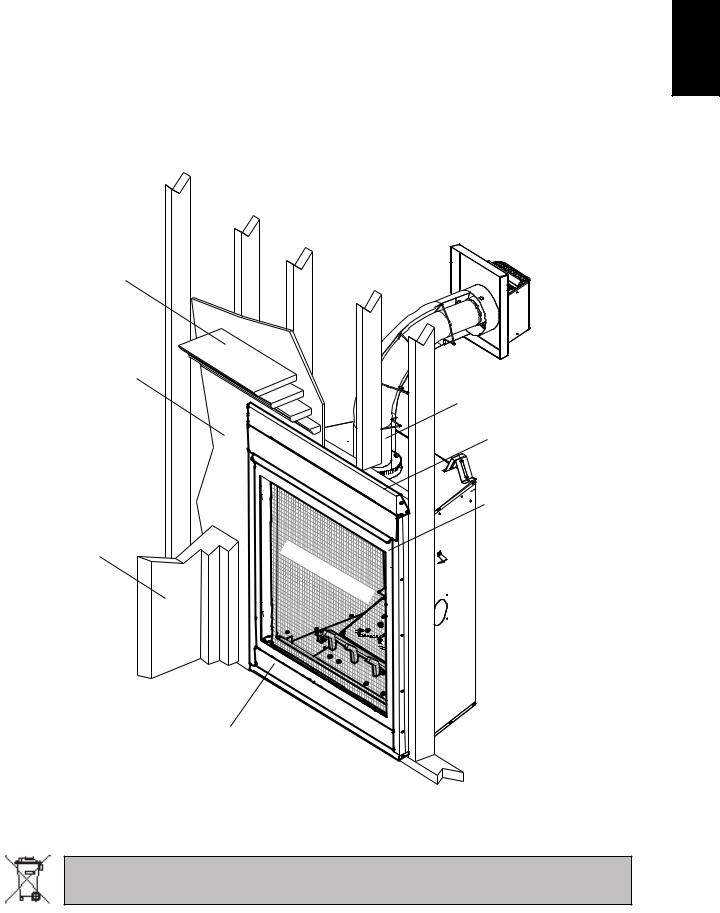
|
|
|
3 |
|
14.0 |
HD40-1 ACCESSORIES |
58 |
|
|
|
|
|||
15.0 |
HD46-1 ACCESSORIES |
60 |
|
|
16.0 |
TROUBLESHOOTING |
62 |
|
EN |
17.0 |
WARRANTY |
64 |
|
|
18.0 |
SERVICE HISTORY |
65 |
|
|
19.0 |
NOTES |
66 |
|
|
NOTE: Changes, other than editorial, are denoted by a vertical line in the margin.
1.0INSTALLATION OVERVIEW
1.1USING COMBUSTIBLE MATERIAL
Mantel, see “MINIMUM MANTEL CLEARANCES” section.
Enclosures, see the section “MINIMUM CLEARANCES TO COMBUSTIBLE ENCLOSURES” section for drywall (or other combustible material).
Framing, see “FRAMING” section.
SAFETY |
BARRIER |
|
Side
Wall
Rating plate, see “RATING PLATE INFORMATION” section.
Venting, see “VENTING” section.
Framing, see “FRAMING” section.
Enclosures, see the section “MINIMUM CLEARANCE TO COMBUSTIBLE ENCLOSURES” section for non-combustible materials such as tile, marble, granite, etc.
Batteries must be disposed of according to the local laws and regulations. Some batteries may be recycled, and may be accepted for disposal at your local recycling center. Check with your municipality for recycling instructions.
W415-2197 / 12.05.16
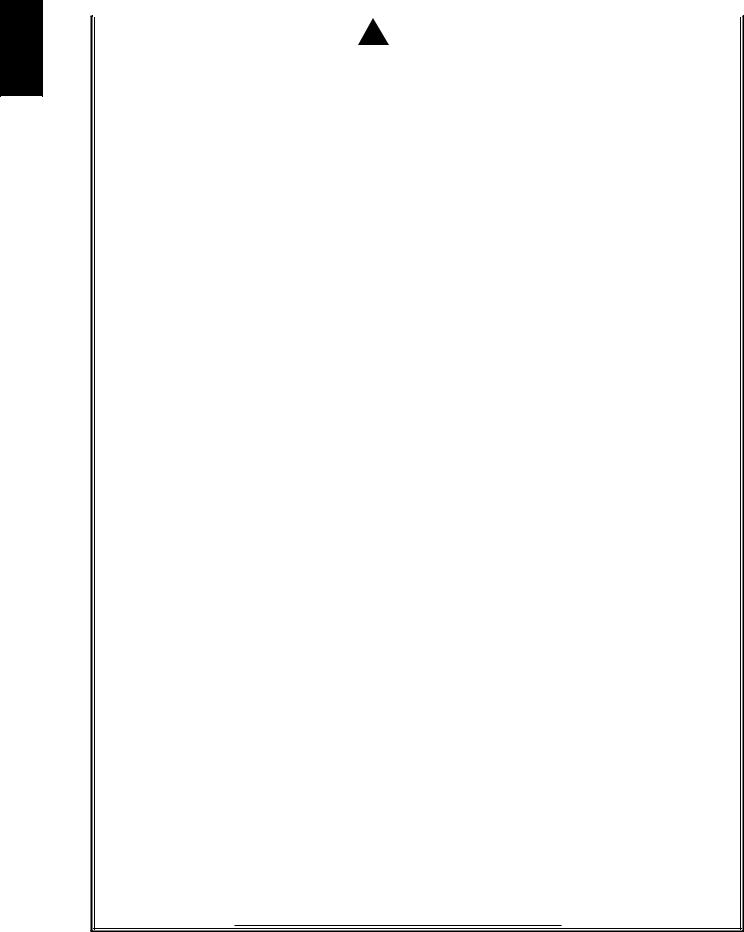
|
4 |
|
|
|
|
2.0 INTRODUCTION |
|
||
|
|
|||
EN |
|
! |
WARNING |
|
|
|
• THIS APPLIANCE IS HOT WHEN OPERATED AND CAN CAUSE SEVERE BURNS IF CONTACTED. |
||
|
|
|
||
|
|
|
• ANY CHANGES OR ALTERATIONS TO THIS APPLIANCE OR ITS CONTROLS CAN BE DANGEROUS AND IS |
|
|
|
|
PROHIBITED. |
|
• Do not operate appliance before reading and understanding operating instructions. Failure to operate appliance according to operating instructions could cause fi re or injury.
• Risk of fi re or asphyxiation do not operate appliance with fi xed glass removed.
• Do not connect 110 volts to the control valve.
• Risk of burns. The appliance should be turned off and cooled before servicing.
• Do not install damaged, incomplete or substitute components.
• Risk of cuts and abrasions. Wear protective gloves and safety glasses during installation. Sheet metal edges may be sharp.
• Do not burn wood or other materials in this appliance.
• Children and adults should be alerted to the hazards of high surface temperature and should stay away to avoid burns or clothing ignition.
• Young children should be carefully supervised when they are in the same room as the appliance. Toddlers, young children and others may be susceptible to accidental contact burns. A physical barrier is recommended if there are at risk individuals in the house. To restrict access to an appliance, install an adjustable safety gate to keep toddlers, young children and other at risk individuals out of the room and away from hot surfaces.
• Clothing or other flammable material should not be placed on or near the appliance.
• Due to high temperatures, the appliance should be located out of traffic and away from furniture and draperies.
• Ensure you have incorporated adequate safety measure to protect infants/toddlers from touching hot surfaces.
• Even after the appliance is out, the glass and/or screen will remain hot for an extended period of time.
• Check with your local hearth specialty dealer for safety screens and hearth guards to protect children from hot
surfaces. These screens and guards must be fastened to the fl oor.
• Any safety screen, guard or barrier removed for servicing the appliance, must be replaced prior to operating the appliance.
• The appliance is a vented gas-fi red appliance. Do not burn wood or other materials in the appliance
• It is imperative that the control compartments, burners and circulating blower and its passageway in the appliance and venting system are kept clean. The appliance and its venting system should be inspected before use and at least annually by a qualifi ed service person. More frequent cleaning may be required due to excessive lint from carpeting, bedding material, etc. The appliance area must be kept clear and free from combustible materials, gasoline and other fl ammable vapors and liquids.
• Under no circumstances should this appliance be modifi ed.
• This appliance must not be connected to a chimney fl ue pipe serving a separate solid fuel burning appliance.
• Do not use this appliance if any part has been under water. Immediately call a qualifi ed service technician to inspect the appliance and to replace any part of the control system and any gas control which has been under water.
• Do not operate the appliance with the glass door removed, cracked or broken. Replacement of the glass should be done by a licensed or qualifi ed service person.
• Do not strike or slam shut the appliance glass door.
• When equipped with pressure relief doors, they must be kept closed while the appliance is operating to prevent exhaust fumes containing carbon monoxide, from entering into the home. Temperatures of the exhaust escaping
through these openings can also cause the surrounding combustible materials to overheat and catch fi re.
• Only doors / optional fronts certified with the appliance are to be installed on the appliance.
• Keep the packaging material out of reach of children and dispose of the material in a safe manner. As with all plastic bags, these are not toys and should be kept away from children and infants.
• As with any combustion appliance, we recommend having your appliance regularly inspected and serviced as well as having a Carbon Monoxide Detector installed in the same area to defend you and your family against Carbon Monoxide.
• Ensure clearances to combustibles are maintained when building a mantel or shelves above the appliance. Elevated temperatures on the wall or in the air above the appliance can cause melting, discolouration or damage of
decorations, a T.V. or other electronic components.
• A barrier designed to reduce the risk of burns from the hot viewing glass is provided with this appliance and shall be installed.
• If the barrier becomes damaged, the barrier shall be replaced with the manufacturer’s barrier for this appliance.
• Installation and repair should be done by a qualified service person. The appliance should be inspected before use and at least annually by a professional service person. More frequent cleaning may be required due to excessive lint from carpeting, bedding material, etc. It is imperative that control compartments, burners and circulating air passageways of the appliance be kept clean.
3.2C
W415-2197 / 12.05.16
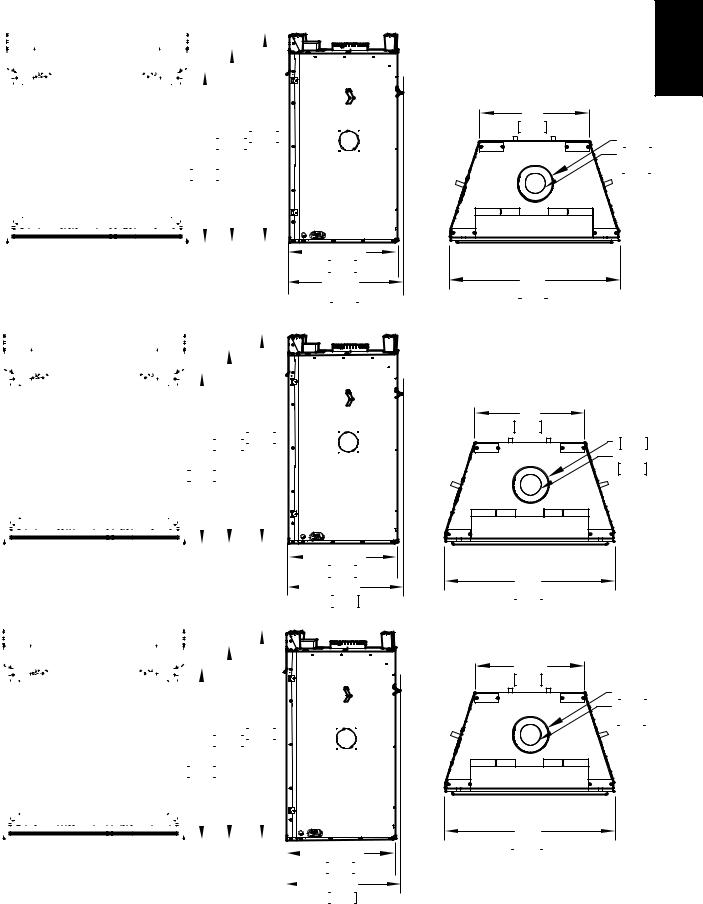
2.1DIMENSIONS
|
|
|
|
|
|
|
|
|
|
|
|
|
|
|
|
|
|
|
|
|
|
|
|
|
|
|
|
|
|
|
|
|
|
|
|
|
|
|
|
|
|
|
|
|
|
|
|
|
|
|
|
|
|
|
|
|
|
|
|
|
|
|
|
|
|
|
|
|
|
|
|
|
|
|
|
|
|
|
|
|
|
|
|
|
|
|
|
|
|
|
|
|
|
|
|
|
|
|
|
|
|
|
|
|
|
|
|
|
|
|
|
|
|
|
|
|
|
|
|
|
|
|
|
|
|
|
|
|
|
|
|
|
|
|
|
|
|
|
|
|
|
|
|
|
|
|
|
|
|
|
|
|
|
|
|
|
|
|
|
|
|
|
|
|
|
|
|
|
|
|
|
|
|
|
|
|
|
|
|
|
|
|
|
|
|
|
|
|
|
|
|
|
|
|
|
|
|
|
|
|
|
|
|
|
|
|
|
|
|
|
|
|
|
|
|
|
|
|
|
|
|
|
|
|
|
|
|
|
|
|
|
|
|
|
|
|
|
|
|
|
|
|
|
|
|
|
|
|
|
|
|
|
|
|
|
|
|
|
|
|
|
|
|
|
|
|
|
|
|
|
|
|
|
|
|
|
|
|
|
|
|
|
|
|
|
|
|
|
|
|
|
|
|
|
|
|
|
|
|
|
|
|
|
|
|
|
|
|
|
|
|
|
|
|
|
|
|
|
|
|
|
|
|
|
|
|
|
|
|
|
|
|
|
|
|
|
|
|
|
|
|
|
|
|
|
|
|
|
|
|
|
|
|
|
|
|
|
|
|
|
|
|
|
|
|
|
|
|
|
|
|
|
|
|
|
|
|
|
|
|
|
|
|
|
|
|
|
|
|
|
|
|
|
|
|
|
|
|
|
|
|
|
|
|
|
|
|
|
|
|
|
|
|
|
|
|
|
|
38" |
|
|
41" |
|
|||||
|
|
|
|
|
|
|
|
|
|
|
|
|
|
|
|
|
|
|
|
|
|
|
|
|
|
|
|
|
|
|
||||||||
|
|
|
|
|
|
|
|
|
|
|
|
|
|
|
|
|
|
|
|
|
|
|
|
|
|
|
|
|
|
|
||||||||
|
|
|
|
|
|
|
|
|
|
|
|
|
|
|
|
|
|
|
|
|
|
|
|
|
|
|
|
|
|
|
||||||||
|
|
|
|
|
|
|
|
|
|
|
|
|
|
|
|
|
|
|
|
|
|
|
|
|
|
|
|
|
|
|
1041mm |
|||||||
|
|
|
|
|
|
|
|
|
|
|
|
|
|
|
|
|
|
|
|
|
|
|
|
|
|
|
|
|
|
|
|
965mm |
|
|
||||
|
|
SAFETY BARRIER |
|
|
|
|
|
|
|
|
|
|
|
|
|
|
|
|||||||||||||||||||||
|
|
|
|
|
33 3/4" |
|
|
|
|
|
|
|
|
|||||||||||||||||||||||||
|
|
|
|
|
|
|
|
|
|
|
|
|
|
|
|
|
|
|
|
|
|
|
|
|
|
|
|
857mm |
|
|
|
|
|
|
|
|||
|
|
|
|
|
|
|
|
|
|
|
|
|
|
|
|
|
|
|
|
|
|
|
|
|
|
|
|
|
|
|
|
|
|
|
||||
|
|
|
|
|
|
|
|
|
|
|
|
|
|
|
|
|
|
|
|
|
|
|
|
|
|
|
|
|
|
|
|
|
|
|
||||
|
|
|
|
|
|
|
|
|
|
|
|
|
|
|
|
|
|
|
|
|
|
|
|
|
|
|
|
|
|
|
|
|
|
|
||||
|
|
|
|
|
|
|
|
|
|
|
|
|
|
|
|
|
|
|
|
|
|
|
|
|
|
|
|
|
|
|
|
|
|
|
|
|
|
|
|
|
|
|
|
|
|
|
|
|
|
|
|
|
|
|
|
|
|
|
|
|
|
|
|
|
|
|
|
|
|
|
|
|
|
|
|
|
|
|
|
|
|
|
|
|
|
|
|
|
|
|
|
|
|
|
|
|
|
|
|
|
|
|
|
|
|
|
|
|
|
|
|
|
|
|
|
|
|
|
|
|
|
|
|
|
|
|
|
|
|
|
|
|
|
|
|
|
|
|
|
|
|
|
|
|
|
|
|
|
|
|
|
|
|
|
|
|
|
|
|
|
|
|
|
|
|
|
|
|
|
|
|
|
|
|
|
|
|
|
|
|
|
|
|
|
|
|
|
|
|
|
|
|
|
|
HD35-1 ILLUSTRATED |
|
|
20 7/8 ” |
|
|||
|
|
530mm |
21 7/8”  556mm
556mm
|
|
|
|
|
|
|
|
|
|
|
|
|
|
|
|
|
|
|
|
|
|
|
|
|
|
|
|
|
|
|
|
|
|
|
|
|
|
|
|
|
|
|
|
|
|
|
|
|
|
|
|
|
|
|
|
|
|
|
|
|
|
|
|
|
|
|
|
|
|
|
|
|
|
|
|
|
|
|
|
|
|
|
|
|
|
|
|
|
|
|
|
|
|
|
|
|
|
|
|
|
|
|
|
|
|
|
|
|
|
|
|
|
|
|
|
|
|
|
|
|
|
|
|
|
|
|
|
|
|
|
|
|
|
|
|
|
|
|
|
|
|
|
|
|
|
|
|
|
|
|
|
|
|
|
|
|
|
|
|
|
|
|
|
|
|
|
|
|
|
|
|
|
|
|
|
|
|
|
|
|
|
|
|
|
|
|
|
|
|
|
|
|
|
|
|
|
|
|
|
|
|
|
|
|
|
|
|
|
|
|
|
|
|
|
|
|
|
|
|
|
|
|
|
|
|
|
|
|
|
|
|
|
|
|
|
|
|
|
|
|
|
|
|
|
|
|
|
|
|
|
|
|
|
|
|
|
|
|
|
|
|
|
|
|
|
|
|
|
|
|
|
|
|
|
|
|
|
|
|
|
|
|
|
|
|
|
|
|
|
|
|
|
|
|
|
|
|
|
|
|
|
|
|
|
|
|
|
|
|
|
|
|
|
|
|
|
|
|
|
|
|
|
|
|
38" |
41" |
||||||
|
|
|
|
|
|
|
|
|
|
|
|
|
|
|
|
|
|
|
|
|
|
|
|
|
|
|
|
|
||||||||
|
|
|
|
|
|
|
|
|
|
|
|
|
|
|
|
|
|
|
|
|
|
|
|
|
|
|
|
|
|
1041mm |
||||||
|
|
SAFETY BARRIER |
|
|
|
|
|
|
|
|
965mm |
|
||||||||||||||||||||||||
|
|
|
|
|
|
|
|
|
|
|
|
|
|
|
|
|||||||||||||||||||||
|
|
|
|
|
|
|
|
|
|
|
|
|
|
|
|
|||||||||||||||||||||
|
|
|
|
|
|
|
|
|
|
|
|
|
|
|
|
|
|
|
|
|
|
|
|
|
|
33 3/4" |
|
|
|
|
|
|
||||
|
|
|
|
|
|
|
|
|
|
|
|
|
|
|
|
|
|
|
|
|
|
|
|
|
|
|
|
857mm |
|
|
|
|
|
|
||
|
|
|
|
|
|
|
|
|
|
|
|
|
|
|
|
|
|
|
|
|
|
|
|
|
|
|
|
|
|
|
|
|
||||
|
|
|
|
|
|
|
|
|
|
|
|
|
|
|
|
|
|
|
|
|
|
|
|
|
|
|
|
|
|
|
|
|
|
|
|
|
|
|
|
|
|
|
|
|
|
|
|
|
|
|
|
|
|
|
|
|
|
|
|
|
|
|
|
|
|
|
|
|
|
|
|
|
|
|
|
|
|
|
|
|
|
|
|
|
|
|
|
|
|
|
|
|
|
|
|
|
|
|
|
|
|
|
|
|
|
|
|
|
|
|
|
|
|
|
|
|
|
|
|
|
|
|
|
|
|
|
|
|
|
|
|
|
|
|
|
|
|
|
|
|
|
|
|
|
|
|
|
HD40-1 ILLUSTRATED |
|
|
|
20 7/8” |
|
|
|
||||
|
|
|
|
|
530mm |
|
|
|
|
|
21 7/8” |
|
|
|
|
|
|
|
|
|
|
|
556mm |
|
|
|
|
|
|
|
|
|
|
|
|
|
|
|
|
|
|
|
|
|
|
|
|
|
|
|
|
|
|
|
|
|
|
|
|
|
|
|
|
|
|
|
|
|
|
|
|
|
|
|
|
|
|
|
|
|
|
|
|
|
|
|
|
|
|
|
|
|
|
|
|
|
|
|
|
|
|
|
|
|
|
|
|
|
|
|
|
|
|
|
|
|
|
|
|
|
|
|
|
|
|
|
|
|
|
|
|
|
|
|
|
|
|
|
|
|
|
|
|
|
|
|
|
|
|
|
|
|
|
|
|
|
|
|
|
|
|
|
|
|
|
|
|
|
|
|
|
|
|
|
|
|
|
|
|
|
|
|
|
|
|
|
|
|
|
|
|
|
|
|
|
|
|
|
|
|
|
|
|
|
|
|
|
|
|
|
|
|
|
|
|
|
|
|
|
|
|
|
|
|
|
|
|
|
|
|
|
|
|
|
|
|
|
|
|
|
|
|
|
|
|
|
|
|
|
|
|
|
|
|
|
|
|
|
|
|
|
|
|
|
|
|
|
|
|
|
|
|
|
|
|
|
|
|
|
|
|
|
|
|
|
|
|
|
|
|
|
|
|
|
|
|
|
|
|
|
|
|
38" |
41" |
|||||||
|
|
|
|
|
|
|
|
|
|
|
|
|
|
|
|
|
|
|
|
|
|
|
|
|
|
|
|||||||||
|
|
|
|
|
|
|
|
|
|
|
|
|
|
|
|
|
|
|
|
|
|
|
|
|
|
|
|
1041mm |
|||||||
|
SAFETY BARRIER |
|
|
|
|
|
|
965mm |
|
||||||||||||||||||||||||||
|
|
|
|
|
|
|
|
|
|
|
|
|
|
||||||||||||||||||||||
|
|
|
|
|
|
|
|
|
|
|
|
|
|
|
|
|
|
|
|
|
|
|
|
|
33 3/4" |
|
|
|
|
|
|
|
|||
|
|
|
|
|
|
|
|
|
|
|
|
|
|
|
|
|
|
|
|
|
|
|
|
|
|
857mm |
|
|
|
|
|
|
|
||
|
|
|
|
|
|
|
|
|
|
|
|
|
|
|
|
|
|
|
|
|
|
|
|
|
|
|
|
|
|
|
|
|
|||
|
|
|
|
|
|
|
|
|
|
|
|
|
|
|
|
|
|
|
|
|
|
|
|
|
|
|
|
|
|
|
|
|
|
|
|
|
|
|
|
|
|
|
|
|
|
|
|
|
|
|
|
|
|
|
|
|
|
|
|
|
|
|
|
|
|
|
|
|
|
|
|
|
|
|
|
|
|
|
|
|
|
|
|
|
|
|
|
|
|
|
|
|
|
|
|
|
|
|
|
|
|
|
|
|
|
|
|
|
|
|
|
|
|
|
|
|
|
|
|
|
|
|
|
|
|
|
|
|
|
|
|
|
|
|
|
|
|
|
|
|
|
|
|
HD46-1 ILLUSTRATED |
|
|
|
|
|
20 7/8” |
|
|
|
|
|||
|
|
|
|
|
|
530mm |
|
|
|
|
|
|
21 7/8” |
|
|
|
|
|
|
|
|
|
|
|
|
|
556mm |
5
EN
23” |
|
584mm |
Ø 7 " |
 178mm
178mm
Ø 4 "  102mm
102mm
35 1/4”  895mm
895mm
28” |
|
711mm |
Ø 7 " |
|
|
|
178mm |
|
Ø 4 " |
|
102mm |
40 1/4”  1022mm
1022mm
34” |
|
864mm |
Ø 7 " |
 178mm
178mm
Ø 4 "  102mm
102mm
46 1/4”  1175mm
1175mm
W415-2197 / 12.05.16
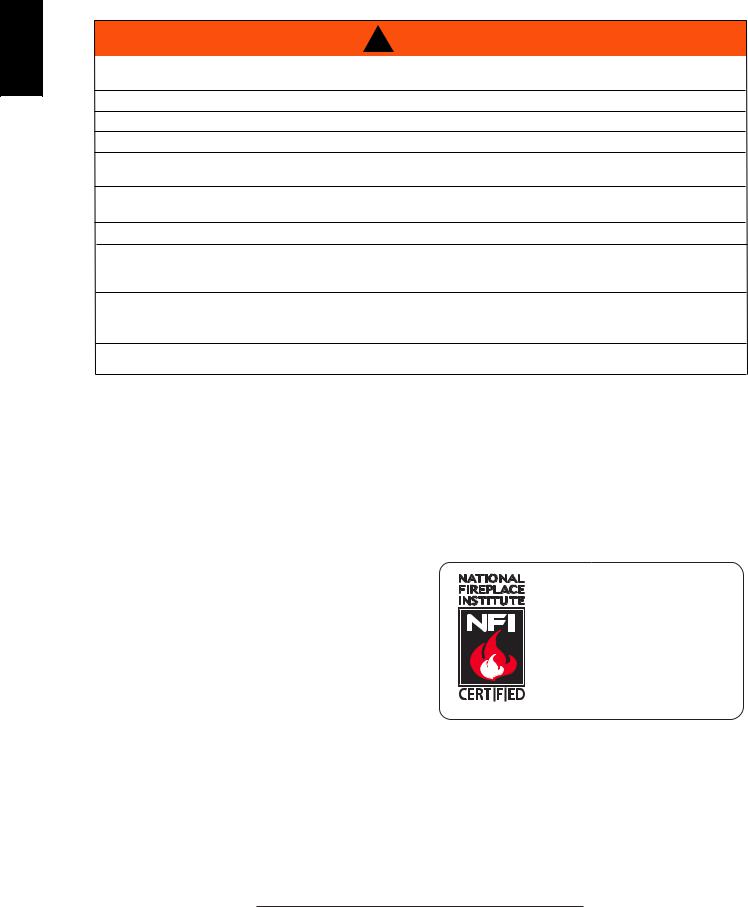
6
2.2GENERAL INSTRUCTIONS
EN |
! WARNING |
ALWAYS LIGHT THE PILOT WHETHER FOR THE FIRST TIME OR IF THE GAS SUPPLY HAS RUN OUT,
WITH THE GLASS DOOR OPENED OR REMOVED.
PROVIDE ADEQUATE CLEARANCE FOR SERVICING AND OPERATING THE APPLIANCE.
PROVIDE ADEQUATE VENTILATION.
NEVER OBSTRUCT THE FRONT OPENING OF THE APPLIANCE.
OBJECTS PLACED IN FRONT OF THE APPLIANCE MUST BE KEPT A MINIMUM OF 48 INCHES
(121.9cm) FROM THE FRONT FACE OF THE APPLIANCE.
SURFACES AROUND AND ESPECIALLY ABOVE THE APPLIANCE CAN BECOME HOT. AVOID CONTACT
WHEN THE APPLIANCE IS OPERATING.
FIRE RISK. EXPLOSION HAZARD.
HIGH PRESSURE WILL DAMAGE VALVE. DISCONNECT GAS SUPPLY PIPING BEFORE PRESSURE TESTING GAS LINE AT TEST PRESSURES ABOVE 1/2 PSIG. CLOSE THE MANUAL SHUT-OFF VALVE BEFORE PRESSURE TESTING GAS LINE AT TEST PRESSURES EQUAL TO OR LESS THAN 1/2 PSIG (35mb).
USE ONLY WOLF STEEL APPROVED OPTIONAL ACCESSORIES AND REPLACEMENT PARTS WITH THIS APPLIANCE. USING NON-LISTED ACCESSORIES (BLOWERS, DOORS, LOUVRES, TRIMS, GAS COMPONENTS, VENTING COMPONENTS, ETC.) COULD RESULT IN A SAFETY HAZARD AND WILL VOID THE WARRANTY AND CERTIFICATION.
THE APPLIANCE MUST NOT BE OPERATED AT TEMPERATURES BELOW FREEZING (32°F / 0°C). ALLOW THE APPLIANCE TO WARM TO ABOVE FREEZING PRIOR TO OPERATION.
THIS GAS APPLIANCE SHOULD BE INSTALLED AND SERVICED BY A QUALIFIED INSTALLER to conform with local codes. Installation practices vary from region to region and it is important to know the specifi cs that apply to your area, for example in Massachusetts State:
•This product must be installed by a licensed plumber or gas fi tter when installed within the commonwealth of Massachusetts.
•The appliance damper must be removed or welded in the open position prior to installation of an appliance insert or gas log.
•The appliance off valve must be a “T” handle gas cock.
•The fl exible connector must not be longer than 3 feet (0.9m).
•A Carbon Monoxide detector is required in all rooms containing gas fi red appliances.
•The appliance is not approved for installation in a bedroom or bathroom unless the unit is a direct vent sealed combustion product.
The installation must conform with local codes or, in absence of local codes, the National Gas and Propane Installation Code CSA B149.1 in Canada, or the National Fuel Gas Code, ANSI Z223.1 / NFPA 54 in the United States. Suitable for mobile home installation if installed in accordance with the current standard CAN/CSA Z240MH Series, for gas equipped mobile homes, in Canada or ANSI Z223.1 and NFPA 54 in the United States.
We suggest that our gas hearth products be installed and serviced by professionals who are certi ed in the U.S. by the National Fireplace Institute® (NFI) as NFI Gas
Specialists
www.n certi ed.org
As long as the required clearance to combustibles is
maintained, the most desirable and benefi cial location for an appliance is in the center of a building, thereby allowing the most effi cient use of the heat created. The location of windows, doors and the traffi c fl ow in the room where the appliance is to be located should be considered. If possible, you should choose a location where the vent will pass through the house without cutting a fl oor or roof joist.
If the appliance is installed directly on carpeting, vinyl tile or other combustible material other than wood fl ooring, the appliance shall be installed on a metal or wood panel extending the full width and depth.
Some appliances have optional fans or blowers. If an optional fan or blower is installed, the junction box must be electrically connected and grounded in accordance with local codes, use the current CSA C22.1 Canadian
Electrical Code in Canada or the ANSI/NFPA 70 National Electrical code in the United States.
4.1C
W415-2197 / 12.05.16
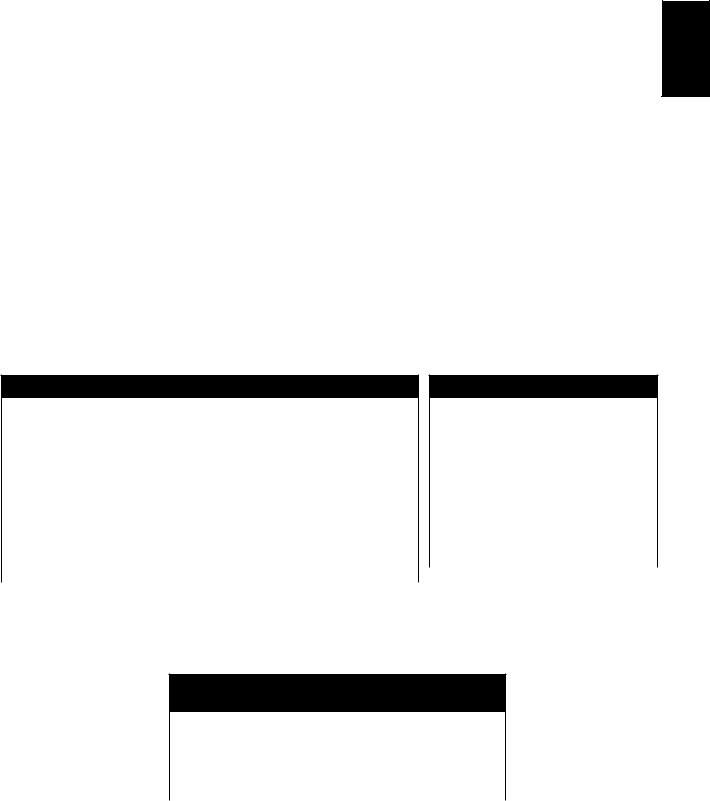
|
7 |
|
2.3 GENERAL INFORMATION |
|
|
|
|
|
FOR YOUR SATISFACTION, THIS APPLIANCE HAS BEEN TEST-FIRED TO ASSURE ITS OPERATION |
|
EN |
AND QUALITY! |
|
|
This appliance is approved for bathroom, bedroom and bed-sitting room installations and is suitable for mobile home installations.
These appliances are equipped with tempered glass. Replacement glass must be obtained from your authorized dealer / distributor and is identified in the replacement parts list. Do not substitute materials.
This appliance is not convertible for use with other gases, unless a certified kit is used.
Expansion / contraction noises during heating up and cooling down cycles are normal and are to be expected. Changes in flame appearance from “HI” to “LO” is more evident in natural gas than in propane.
Use only accessories designed for and listed with your specific appliance.
High Elevations
Input ratings are shown in BTU per hour and are certified without de-rating up to 4,500 feet (1372m) above sea level. For Installations at the elevations above 4,500 feet (1372m) and in the absence of specific
recommendations from the local authority having jurisdiction, the high altitude input rating shall be reduced at the rate of 4% for each additional 1,000 feet (305m).
GAS SPECIFICATIONS
Model |
Fuel |
Gas |
Max. |
Min. |
Air shutter setting |
|
|
Control |
Input |
Input |
|
|
|
|
BTU/h |
BTU/h |
|
HD35-1NT |
Nat |
IPI Hi/Lo |
25,000 |
17,500 |
1/8” (3mm) Open |
HD35-1PT |
Prop* |
IPI Hi/Lo |
25,000 |
17,500 |
3/8” (10mm) Open |
HD40-1NT |
Nat |
IPI Hi/Lo |
27,000 |
18,900 |
1/8” (3mm) Open |
HD40-1PT |
Prop* |
IPI Hi/Lo |
27,000 |
18,900 |
7/16” (11mm) Open |
HD46-1NT |
Nat |
IPI Hi/Lo |
30,000 |
21,000 |
1/8” (3mm) Open |
HD46-1PT |
Prop* |
IPI Hi/Lo |
30,000 |
21,000 |
3/8” (10mm) Open |
EFFICIENCY RATINGS
Model |
Steady |
AFUE%** |
|
State(%) |
|
HD35-1NT |
82.1% |
77.2% |
HD35-1PT |
82.1% |
77.2% |
HD40-1NT |
80.5% |
76.3% |
HD40-1PT |
80.5% |
76.3% |
HD46-1NT |
82.9% |
79.2% |
HD46-1PT |
82.9% |
79.2% |
IPI - Intermittent Pilot Ignition System
*Using conversion kit
**Maximum Values
Conversions between fuel types must be performed by a qualified service technician using only the Wolf Steel certified conversion kit.
GAS INLET AND MANIFOLD
PRESSURES
|
Natural |
Propane |
Minimum Inlet |
4.5” (11mb) w.c. |
11” (27mb) w.c. |
Maximum Inlet |
13” (32mb) w.c. |
13” (32mb) w.c. |
Manifold Pressure |
3.5” (9mb) w.c. |
10” (25mb) w.c. |
The optional heat circulating blower is supplied with a cord.
The junction box must be electrically connected and grounded in accordance with local codes. In the absence of local codes, use the current CSA C22.1 Canadian Electrical Code in Canada or the ANSI/NFPA 70 National Electrical Code in the United States.
This appliance is equipped with a power back up control system. Four “AA” batteries (not supplied) are required for the battery pack included in the system. Use Alkaline batteries only.
W415-2197 / 12.05.16

8
EN



 63.3%
63.3%













 HD35-1
HD35-1
64.3% |
HD40-1 |
65.1% |
HD46-1 |
2.4RATING PLATE INFORMATION
CONFORMS TO / CONFORME AUX: ANSI Z21.50-2014, CERTIFIED TO / CERTIFIE CSA 2.22-2014 VENTED GAS FIREPLACE / FOYER À GAZ VENTILÉ.ES: |
|||||
SAMPLE |
|
||||
DIRECT VENT GAS FIREPLACE . SUITABLE FOR BEDROOM, BATHROOM AND BED-SITTING |
|
|
FOYER À GAZ VENTILÉ. HOMOLOGUÉ POUR INSTALLATION DANS UNE CHAMBRE À COUCHER, UNE SALLE DE BAIN ET |
||
ROOM INSTALLATION. SUITABLE FOR MOBILE HOME INSTALLATION IF INSTALLED IN |
|
|
UN STUDIO. APPROPRIÉ POUR INSTALLATION DANS UNE MAISON MOBILE SI SON INSTALLATION EST CONFORME AUX |
||
ACCORDANCE WITH THE CURRENT STANDARD CAN/CSA Z240MH SERIES GAS EQUIPPED MOBILE |
|
|
EXIGENCES DE LA NORME CAN/CSA Z240MH SÉRIE DE MAISONS MOBILES ÉQUIPÉES AU GAZ, EN VIGUEUR AU CANADA, |
||
|
|
OU AUX ÉTATS-UNIS, SELON LA NORM |
DE SÉCURITÉ ET DE CONSTRUCTION DE MAISONS MANUFACTURÉES, TITRE 24 |
||
HOMES, IN CANADA OR IN THE UNITED STATES THE MANUFACTURED HOME CONTRUCTION |
|
|
CFR, S CTION 3280. DANS L CAS OÙ C TTE NORME DES ÉTATS-UNIS NE PEUT ÊTRE APPLIQUÉE, SE RÉFÉRER À LA |
||
AND SAFETY STANDARD, TITLE 24 CFR, PART 3280. WHEN THIS US STANDARD IS NOT APPLICABLE |
|
|
NORM RELATIVE AU CRITÈRE DE M SUR S DE SÉCURITÉ CONTRE L'INCENDIE POUR LES INSTALLATIONS DANS LES |
||
USE THE STANDARD FOR FIRE SAFETY CRITERIA FOR MANUFACTURED HOME INSTALLATIONS, SITES |
C E R T I F I E D |
|
MAISONS MANUFACTURÉ S, L S SIT S |
|
T L S COMMUNAUTÉS, ANSI/NFPA 501A. LORSQU'IL EST INSTALLÉ AVEC LE |
AND COMMUNITIES, ANSI / NFPA 501A. WHEN INSTALLED WITH SCREEN KIT GD-565KT, THE FIREPLACE |
|
|
PARE-ÉTINCELL S GD-565KT, L FOY R |
|
ST CONFORME À LA NORME DE CERTIFICATION DE L'ACG CR95-006. POUR |
COMPLIES WITH CGA CERTIFICATION REQUIREMENT CR95-006. FOR USE ONLY WITH BARRIER |
CERTIFIED FOR |
|
UNE UTILIS R S ULM NT AV C BARRIÈRE W565-0175. SUIVEZ LES INSTRUCTIONS D'INSTALLATION SE TROUVENT |
||
CANADA USA |
DANS LE MANU L D'INSTALLATION. |
|
|
||
W565-0175. FOLLOW THE INSTALLATION INSTRUCTIONS LOCATED IN THE INSTALLATION MANUAL. |
CERTIFIEE POUR |
|
|
|
|
|
|
Natural Gas/Gaz Naturel |
REFERENCE # 161746 |
|
|
|
Propane |
|
||||||||
|
|
|
|
|
|
|
|
|||||||||
HD46NT |
|
|
CHD46NT |
|
|
|
MODEL |
|
|
|
HD46PT |
|
CHD46PT |
|||
|
|
|
|
0-4500 FT (0-1370m) |
|
|
|
|
ALTITUDE / E EVATION |
|
0-4500FT (0-1370m) |
|
||||
|
|
|
|
30,000 BTU/h |
|
|
|
|
IN UT/A IMENTATION |
|
30,000 BTU/h |
|
||||
|
|
|
|
21,000 BTU/h |
|
|
REDUCED IN UT/A IMENTATION REDUITE |
|
21,000 BTU/h |
|
||||||
|
|
|
|
MANIFOLD PRESSURE: 3.5” WATER COLUMN |
MANIFO D R ESSURE: 10" WATER COLUMN |
|
||||||||||
|
|
|
PRESSIONAU COLLECTEUR: 3.5" D'UNE COLONNE D'EAU |
RESSION AU CO ECTEUR: 10" D'UNE COLONNE D'EAU |
|
|||||||||||
|
|
|
|
MINIMUM SUPPLY PRESSURE: 4.5" WATER COLUMN |
MINIMUM SU |
LY PRESSURE: 11" WATER COLUMN |
|
|||||||||
|
|
PRESSION D'ALIMENTATION MINIMALE: 4.5" D'UNE COLONNE D'EAU |
RESSION D'ALIMENTATION MINIMALE: 11" D'UNE COLONNE D'EAU |
|||||||||||||
|
|
|
|
MAXIMUM SUPPLY PRESSURE: 7.0" WATER COLUMN |
MAXIMUM SU |
LY PRESSURE: 13" WATER COLUMN |
|
|||||||||
|
|
|
PRESSION D'ATATION MAXIMALE: 7.0" D'UNE COLONNE D'EAU |
RESSION D'ALIMENTATION MAXIMALE: 13" D'UNE COLONNE D'EAU |
||||||||||||
THIS VENTED GAS FIREPLACE IS NOT FOR USE WITH AIR FILTERS AND NOT |
4: 65.1% |
4: 65.1% |
|
|
|
|
|
|||||||||
|
|
CE FOYER À GAZ VENTILÉS NE DOIT PAS ÊTRE UTILISÉ AVEC DES FILTRES À AIR |
||||||||||||||
FOR USE WITH SOLID FUEL. FOR USE WITH GLASS DOORS CERTIFIED WITH THIS UNIT ONLY |
ET NE DOIT PAS ÊTRE UTILISÉ AVEC UN COMBUSTIBLE SOLIDE. UTILISER AVEC |
|||||||||||||||
WARNING: DO NOT ADD ANY MATERIAL TO THE APPLIANCE, WHICH WILL CO E IN |
|
|
|
|
|
LES PORTES VITRÉES HOMOLOGUÉES AVEC CETTE UNITÉ SEULEMENT. |
||||||||||
CONTACT WITH THE FLAMES, OTHER THAN THAT SUPPLIED BY THE MANUFACTURER WITH |
|
|
AVERTISSEMENT: N’A JOUTEZ PAS A CET APPAREIL AUCUN MATERIAU DEVANT ENTRER EN CONTACT AVEC |
|||||||||||||
THE APPLIANCE. |
|
|
|
|
|
|
|
|
|
|||||||
|
|
|
|
|
|
|
|
|
LES FLAMMES AUTRE QUE CELUI QUI EST FOURNI AVEC CET APPAREIL PAR LE FABRICANT. |
|||||||
DECORATIVE PRODUCT: NOT FOR USE AS A HEATING PPLI NCE |
|
|
|
|
|
|||||||||||
|
|
|
|
|
PRODUIT DÉCORATIF: NE PAS UTILISER COMME APPAREIL DE CHAUFFAUGE |
|||||||||||
MINIMUM CLEARANCE TO COMBUSTIBLE MATERIALS / DEG GEMENTS MINI UX DES |
TERI UX CO BUSTIBLES: |
|||||||||||||||
THE APPLIANCE MIST BE VENTED USING THE APPROPROATE WOLF STEEL VENT KITS. SEE OWNERS |
||||||||||||||||
|
TOP/DESSUS |
0 RECESSED DEPTH / PROFONDEUR D'ENCASTRE 20½" |
||||||||||||||
|
INSTALLATION MANUAL FOR VENTING SPECIFICS. PROPER REINSTALLATION AND RESEALING IS NECESSARY |
|||||||||||||||
WOLF STEEL LTD. |
FLOOR / PL NCHER |
0 VENT SIDES / COTES DE L'EVENT |
|
1" |
AFTER SERVICING THE VENT-AIR INTAKE SYSTEM. L’APPAREIL DOIT ÉVACUER SES GAZ EN UTILISANT |
|||||||||||
SIDES / COTES |
0 VENT TOP/ DESSUS DE L’ÉVENT |
|
2" |
|||||||||||||
24 Napoleon Rd. Barrie, |
|
L’ENSEMBLE D’EVACUATION PROPRE À WOLF STEEL. SE RÉFÉRER AU MANUEL D’INSTALLATION DU |
||||||||||||||
BACK/ ARRIERE |
0 VENT BOTTOM / DESSOUS DE L’ÉVENT |
1" |
PROPRIÉTAIRE POUR LES SPÉCIFICATIONS DE L’ÉVACUATION. IL EST IMPORTANT DE BIEN RÉINSTALLER ER |
|||||||||||||
Ontario L4M 0G8 Canada |
MANTLE / M NTE U |
13"* |
|
|
|
|
|
RESCELLER L’ÉVENT APRÉS AVOIR EFFECTUÉ LE SERVICE DU SYSTÊM DE PRISE D’AIR |
||||||||
|
*MAXIMUM HORIZONT L EXTEN ION / EXTENSION HORIZONTALE MAXIMALE: 2". |
ELECTRICAL RATING / CLASSIFICATION: 115V, 60HZ, LESS THAN 12 AMPS. |
||||||||||||||
WOLF STEEL USA |
E IN TRUCTION MANU L FOR GREATER EXTENSIONS S E |
RÉFÉRER AU |
||||||||||||||
SPÉCIFICATIONS ÉLECTRIQUES : 115 V, 60 HZ, MOINS DE 12 A. |
||||||||||||||||
103 Miller Drive, |
MANUEL D'IN TRUCTION POUR DES EXTENSIONS PLUS GRANDES. |
OPTIONAL FAN KIT / SOUFFLERIE OPTIONNELLE : GZ550-KT, GD65 |
||||||||||||||
Crittenden, Kentucky, USA, 41030 |
EE OWNER'S IN TRUCTION MANUAL FOR MINIMUM AND MAXIMUM VENT LENGTHS. |
|
|
|
|
|
|
|||||||||
E RÉFÉRER AU MANUEL D'IN TALLATION DU PRO PRIÉTAIRE POUR LES LONGUEURS |
|
|
|
|
||||||||||||
|
|
|
|
|
||||||||||||
D'EVACUATION MINIMALE EV MAXIMALE. |
SERIAL NUMBER/NO. DE SERIE: |
|
|
|
HD46 |
W385-1995 |
|||
|
||||
|
|
|
INSTALLER: It is your responsibility to check off the appropriate box on the rating plate according to the model, venting and gas type of the appliance.
For rating plate location, see “INSTALLATION OVERVIEW” section.
This illustration is for reference only. Refer to the rating plate on the appliance for accurate information.
NOTE: The rating plate must remain with the appliance at all times. It must not be removed.
A barrier designed to reduce the risk of burns from the hot viewing glass is provided with the appliance and must be installed.
W415-2197 / 12.05.16
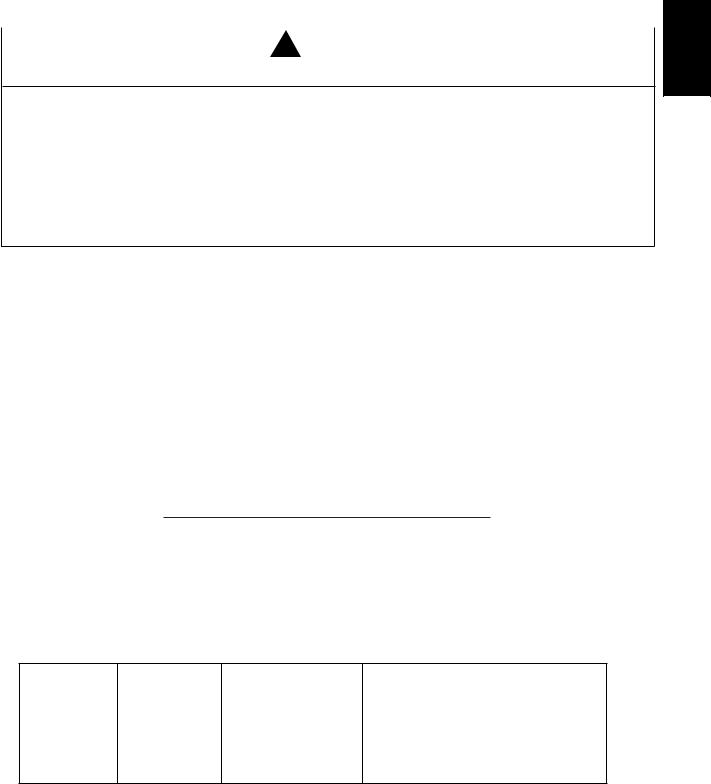
9
3.0 VENTING
|
|
|
|
! WARNING |
EN |
RISK OF FIRE, MAINTAIN SPECIFIED AIR SPACE CLEARANCES TO VENT PIPE AND APPLIANCE.
IF VENTING IS INCLUDED WITH SPACERS THE VENT SYSTEM MUST BE SUPPORTED EVERY 3FT (0.9m) FOR BOTH VERTICAL AND HORIZONTAL RUNS. USE SUPPORTS OR EQUIVALENT NON-COMBUSTIBLE STRAPPING TO MAINTAIN THE REQUIRED CLEARANCE FROM COMBUSTIBLES. USE WOLF STEEL LTD. SUPPORT RING ASSEMBLY W010-0370 OR EQUIVALENT NON-COMBUSTIBLE STRAPPING TO MAINTAIN THE MINIMUM CLEARANCE TO COMBUSTIBLES FOR BOTH VERTICAL AND HORIZONTAL RUNS. SPACERS ARE ATTACHED TO THE INNER PIPE AT PREDETERMINED INTERVALS TO MAINTAIN AN EVEN AIR GAP TO THE OUTER PIPE. THIS GAP IS REQUIRED FOR SAFE OPERATION. A SPACER IS REQUIRED AT THE START, MIDDLE AND END OF EACH ELBOW TO ENSURE THIS GAP IS MAINTAINED. THESE SPACERS MUST NOT BE REMOVED.
THIS APPLIANCE USES A 4” (102mm) EXHAUST / 7” (178mm) AIR INTAKE VENT PIPE SYSTEM. Refer to the section applicable to your installation.
For safe and proper operation of the appliance follow the venting instruction exactly. Deviation from the minimum vertical vent length can create diffi culty in burner start-up and/or carboning. Under extreme vent confi gurations, allow several minutes (5-15) for the fl ame to stabilize after ignition. Although not a
requirement, it is recommended for vent lengths that pass through unheated spaces (attics, garages, crawl spaces) be insulated with the insulation wrapped in a protective sleeve to minimize condensation. Provide a means for visually checking the vent connection to the appliance after the appliance is installed. Use a
fi restop, vent pipe shield or attic insulation shield when penetrating interior walls, fl oor or ceiling.
The vent terminal may be painted with a high temperature paint to match exterior colours. Use an outdoor paint suitable for 400°F (204°C). Application and performance of paint is the consumer’s responsibility. Spot
testing is recommended.
NOTE: If for any reason the vent air intake system is disassembled; reinstall per the instructions provided for the initial installation.
NOTE: This appliance must be installed with a continuous connection of exhaust and air intake vent pipes. Utilizing alternate constructions such as a chimney as part of the vent system is not permitted.
7.1F
3.1VENTING LENGTHS AND COMPONENTS
Use only Wolf Steel, Simpson Dura-Vent, Selkirk Direct Temp, American Metal Amerivent or Metal-Fab venting components. Minimum and maximum vent lengths, for both horizontal and vertical installations, clearances from vent pipes to combustibles and air terminal locations as set out in this manual apply to all vent systems and must be adhered to. For Simpson Dura-Vent, Selkirk Direct Temp, American Metal Amerivent and Metal-Fab follow the installation procedure provided with the venting components.
A starter adaptor must be used with the following vent systems and may be purchased from the corresponding supplier:
PART |
4”/7” |
SUPPLIER |
WEBSITE |
|
|
|
|
Duravent |
W175-0053 |
Wolf Steel |
www.duravent.com |
|
|
|
|
Amerivent |
4DSC-N2 |
American Metal |
www.americanmetalproducts.com |
|
|
|
|
Direct Temp |
4DT-AAN |
Selkirk |
www.selkirkcorp.com |
|
|
|
|
SuperSeal |
4DNA |
Metal-Fab |
www.mtlfab.com |
For Simpson Dura-Vent, Selkirk Direct Temp, American Metal Amerivent and Metal-Fab follow the installation procedure found on the website for your venting supplier.
For vent systems that provide seals on the inner exhaust fl ue, only the outer air intake joints must be sealed using a red high temperature silicone (RTV). This same sealant may be used on both the inner exhaust and outer intake vent pipe joints of all other approved vent systems except for the exhaust vent pipe connection to the appliance fl ue collar which must be sealed using the black high temperature sealant Mill Pac. High temperature sealant must be ordered separately.
W415-2197 / 12.05.16
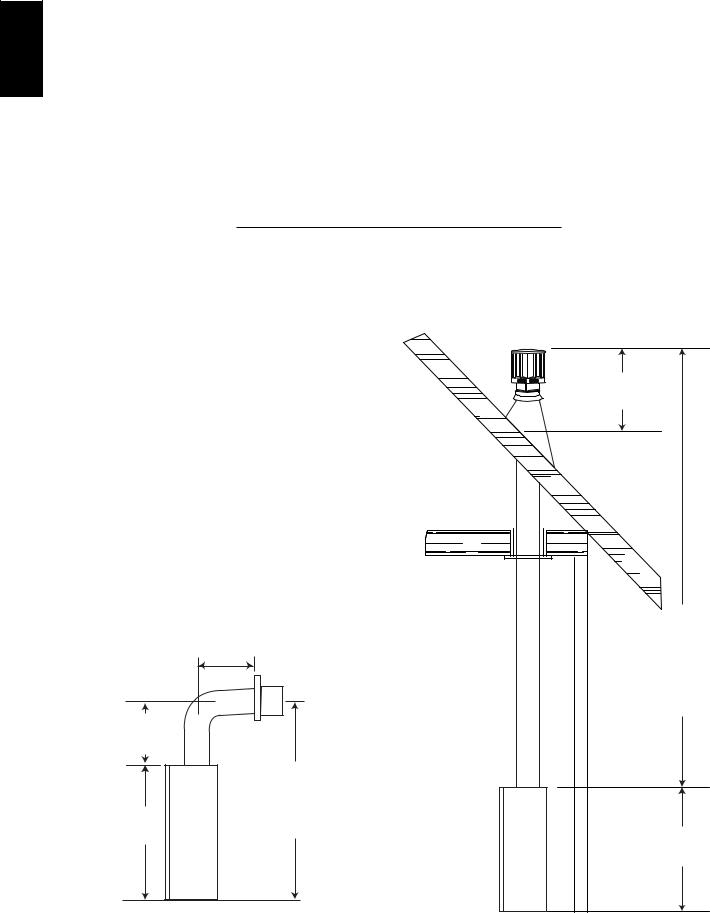
|
10 |
|
When using Wolf Steel venting components, use only approved Wolf Steel rigid / fl exible components with |
|
the following termination kits: wall terminal kit GD-222, GD-222R, or 1/12 to 7/12 pitch roof terminal kit |
|
|
|
GD-110, 8/12 to 12/12 roof terminal kit GD-111, fl at roof terminal kit GD-112 or periscope kit GD-201 (for |
EN |
wall penetration below grade). With fl exible venting, in conjunction with the various terminations, use either |
the 5 foot (1.5m) vent kit GD-220 or the 10 foot (3.1m) vent kit GD-330. |
For optimum flame appearance and appliance performance, keep the vent length and number of elbows to a minimum. The air terminal must remain unobstructed at all times. Examine the air terminal at least once a year to verify that it is unobstructed and undamaged.
Rigid and flexible venting systems must not be combined. Different venting manufacturer components must not be combined.
These vent kits allow for either horizontal or vertical venting of the appliance. The maximum allowable horizontal run is 20 feet (6.1m). The maximum allowable vertical vent length is 40 feet (12.2m). The maximum number of vent connections is two horizontally or three vertically (excluding the appliance and the air terminal connections) when using fl exible venting.
8.1B
Horizontal runs may have a 0” rise per foot however for optimum performance it is recommended that all horizontal runs have a minimum 1/4" (6mm) rise per foot using flexible or rigid venting. For safe and proper operation of the appliance, follow the venting instructions exactly.
When terminating vertically, the vertical rise is a minimum 3 feet (1m) and a maximum 40 feet (12m) from the
top of the appliance.
3.2 TYPICAL VENT INSTALLATIONS
16" (40.6cm) MIN
|
24" |
40FT (12m) |
|
|
(61cm) MAX |
MAX |
|
|
|
3FT (1m) |
|
|
|
MIN |
|
19 1/2" (49.5cm) |
|
|
|
MIN |
|
|
|
|
57 1/2" |
|
|
|
(146cm) |
|
|
38" |
MIN PLUS |
|
|
RISE* |
|
||
(96.5cm) |
38" |
||
|
|||
|
|
(96.5cm) |
|
* See “VENTING” section. |
|
||
W415-2197 / 12.05.16
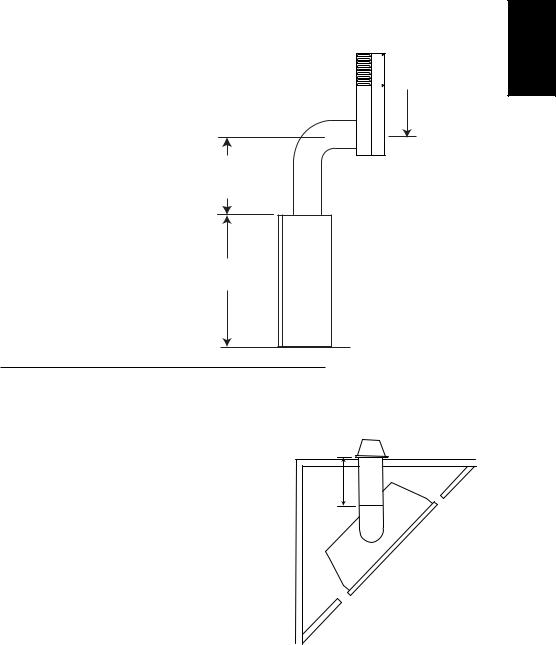
3.3SPECIAL VENT INSTALLATIONS
3.3.1 PERISCOPE TERMINATION
Use the periscope kit to locate the air termination above grade. The periscope must be installed so that when fi nal grading is completed, the bottom air slot is located a minimum 12” (30.5cm) above grade. The maximum allowable vent length is 10’ (3m) for a fi replace and 8’ (2m) for a stove.
30"
(76.2cm) MIN
38"
(96.5cm)
11
EN

 12" (30.5cm) MIN TO GRADE
12" (30.5cm) MIN TO GRADE
|
|
9.1B |
3.3.2 |
CORNER TERMINATION |
|
|
The maximum vent length for a corner installation is 20" (50.8cm) of |
|
|
horizontal run with a minimum 19 1/2" (49.5cm) rise. |
20” (508mm) |
|
|
MAX |
|
|
MAX. |
|
|
20” |
|
|
(50.8cm) |
W415-2197 / 12.05.16
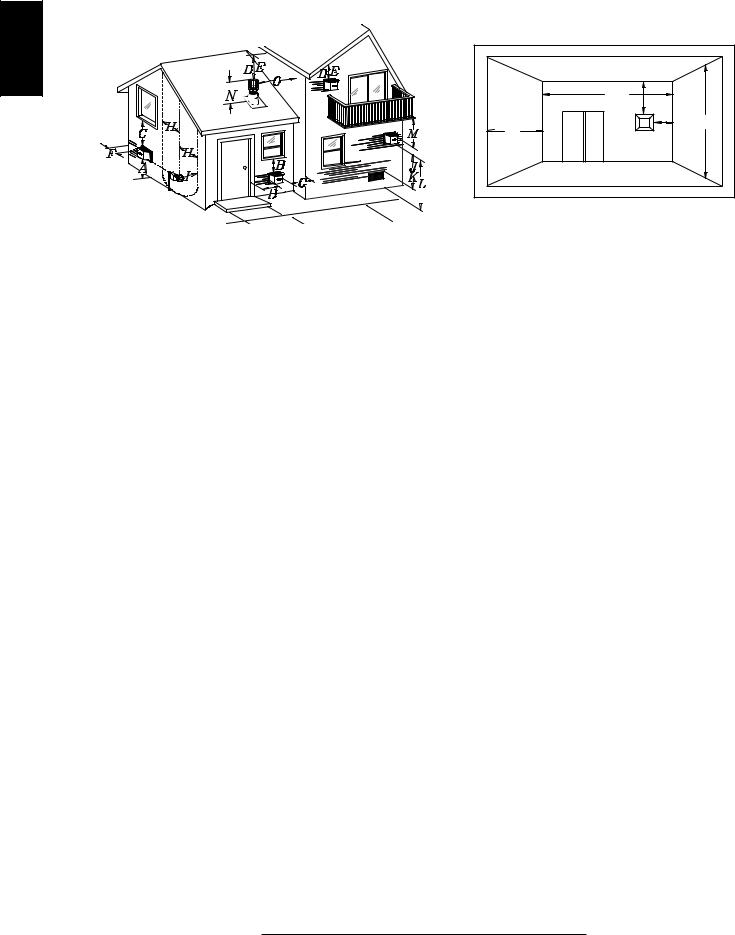
12
3.4VENT TERMINAL CLEARANCES
EN
COVERED BALCONY APPLICATIONS ††*
|
Q |
S |
|
|
|
|
|
R |
|
G |
P |
|
|
|
|
|
|
|
|
|
|
|
|
|
|
|
|
|
|
|
|
|
|
|
|
|
|
|
|
|
|
QMIN = 3 feet |
|
R MAX = 2 x QACTUAL |
RMAX ≤ 15 feet |
|
|
|
|
|
|
|
|
|
|
|
||||||||
|
|
|
|
|
|
|
|
|
|
|
(0.9m) |
|
|
(4.6m) |
|
|
|
INSTALLATIONS |
|
|
|
|
|
|
|
|
|
||||||
|
CANADA |
U.S.A. |
|
|
|
|
|
|
|
|
|
|||||
A |
12” (30.5cm) |
12” (30.5cm) |
Clearance above grade, veranda porch, deck or balcony. |
|
|
|
||||||||||
B |
12” (30.5cm) |
9” (229mm) |
Clearance to windows or doors that open. |
|
|
|
||||||||||
C |
12” (30.5cm)* |
12” (30.5cm) * |
Clearance to permanently closed windows. |
|
|
|
||||||||||
D |
18” |
18” |
Vertical clearance to ventilated soffi ts located above the terminal within a horizontal distance of 2’ |
|||||||||||||
(45.7cm)** |
(45.7cm)** |
(0.6m) from the center line of the terminal. |
|
|
|
|||||||||||
|
|
|
|
|||||||||||||
E |
12” (30.5cm)** |
12” (30.5cm)** |
Clearance to unventilated soffi t. |
|
|
|
||||||||||
F |
0” (0mm) |
0” (0mm) |
Clearance to an outside corner wall. |
|
|
|
||||||||||
G |
0” (0mm)*** |
0” (0mm)*** |
Clearance to an inside non-combustible corner wall or protruding non-combustible obstructions (chimney, etc.). |
|||||||||||||
2” (51mm)*** |
2” (51mm)*** |
Clearance to an inside combustible corner wall or protruding combustible obstructions (vent chase, etc.). |
||||||||||||||
|
||||||||||||||||
H |
3’(0.9m) |
3’(0.9m)**** |
Clearance to each side of the center line extended above the meter / regulator assembly to a maxi- |
|||||||||||||
mum vertical distance of 15’ (4.6m). |
|
|
|
|||||||||||||
|
|
|
|
|
|
|
|
|
|
|||||||
I |
3’ (0.9m) |
3’ (0.9m)**** |
Clearance to a service regulator vent outlet. |
|
|
|
||||||||||
J |
12” (30.5cm) |
9” (229mm) |
Clearance to a non-mechanical air supply inlet to the building or a combustion air inlet to any other appliance. |
|||||||||||||
K |
6’ (1.8m) |
3’ (0.9m) † |
Clearance to a mechanical air supply inlet. |
|
|
|
||||||||||
L |
7’ (2.1m) ‡ |
7’ (2.1m) **** |
Clearance above a paved sidewalk or paved driveway located on public property. |
|
|
|||||||||||
M |
12” (30.5cm)†† |
12” (30.5cm)**** |
Clearance under a veranda, porch or deck. |
|
|
|
||||||||||
|
|
|
|
|
|
|
|
|
|
|
|
|
||||
N |
16” (40.6cm) |
16” (40.6cm) |
Clearance above the roof. |
|
|
|
||||||||||
O |
2’ (0.6m)†* |
2’ (0.6m) †* |
Clearance from an adjacent wall including neighbouring buildings. |
|
|
|||||||||||
P |
8’ (2.4m) |
8’ (2.4m) |
Roof must be non-combustible without openings. |
|
|
|
||||||||||
Q |
3’ (0.9m) |
3’ (0.9m) |
See chart for wider wall dimensions. |
|
|
|
||||||||||
R |
6’ (1.8m) |
6’ (1.8m) |
See chart for deeper wall dimensions. The terminal shall not be installed on any wall that has an |
|||||||||||||
opening between the terminal and the open side of the structure. |
|
|
||||||||||||||
|
|
|
|
|
|
|
|
|
||||||||
S |
12” (30.5cm) |
12” (30.5cm) |
Clearance under a covered balcony |
|
|
|
||||||||||
The terminal shall not be located less than 6 feet under a window that opens on a horizontal plane in a structure with three walls and a roof.
*Recommended to prevent condensation on windows and thermal breakage
** It is recommended to use a heat shield and to maximize the distance to vinyl clad soffi ts.
*** The periscope requires a minimum 18 inches clearance from an inside corner.
**** This is a recommended distance. For additional requirements check local codes.
†3 feet above if within 10 feet horizontally.
‡ A vent shall not terminate where it may cause hazardous frost or ice accumulations on adjacent property surfaces.
††Permitted only if the veranda, porch, or deck is fully open on a minimum of two sides beneath the fl oor.
†* |
Recommended to prevent recirculation of exhaust products. For additional requirements check local codes. |
††* |
Permitted only if the balcony is fully open on a minimum of one side. |
NOTE: Clearances are in accordance with local installation codes and the requirements of the gas supplier.
12.1E
W415-2197 / 12.05.16
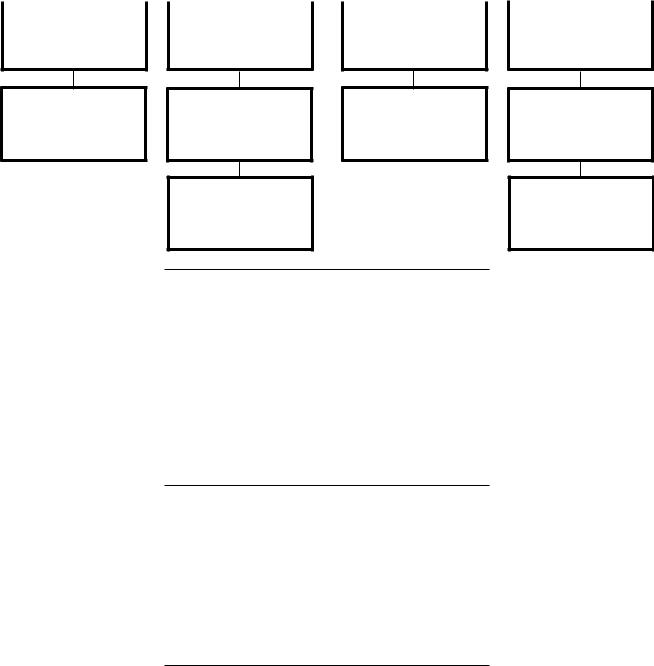
|
|
|
|
|
|
|
|
13 |
|||||
3.5 VENT APPLICATION FLOW CHART |
|
|
|
|
|
|
|||||||
|
|
|
|
|
|
||||||||
|
|
|
|
|
|
|
|
|
|
|
|
|
|
|
|
|
|
|
TOP EXIT |
|
|
|
|
|
EN |
||
|
|
|
|
|
|
|
|
|
|
|
|
|
|
|
Horizontal Termination |
|
|
Vertical Termination |
|
|
|||||||
|
|
|
|
|
|
|
|
|
|
|
|
|
|
Vertical rise is equal to or greater than the horizontal run
Horizontal run + vertical rise to maximum of 40 feet (12m)
Vertical rise is less than horizontal run
Horizontal run + vertical rise to maximum of 24.75 feet (7.5m)
4.2 times the vertical rise equal to or greater than the horizontal run
Vertical rise is equal to or greater than the horizontal run
Horizontal run +
vertical rise to maximum of 40 feet
(12m)
Vertical rise is less than horizontal run
Horizontal run + vertical rise to maximum of 40 feet (12m)
3 times the vertical rise equal to or greater than the horizontal run
13.1A
3.6DEFINITIONS
For the following symbols used in the venting calculations and examples are:
>- greater than
>- equal to or greater than < - less than
< - equal to or less than
HT - total of both horizontal vent lengths (Hr) and offsets (Ho) in feet HR - combined horizontal vent lengths in feet
HO - offset factor: .03 (total degrees of offset - 90°*) in feet VT - combined vertical vent lengths in feet
14.1
3.7ELBOW VENT LENGTHS
1° |
FEET |
INCHES |
MILLIMETERS |
0.03 |
0.5 |
12.7 |
|
15° |
0.45 |
6.0 |
152.4 |
30° |
0.9 |
11.0 |
279.4 |
45° |
1.35 |
16.0 |
406.4 |
90°* |
2.7 |
32.0 |
812.8 |
* The fi rst 90° offset has a zero value and is shown in the formula as - 90°
15.1A
W415-2197 / 12.05.16
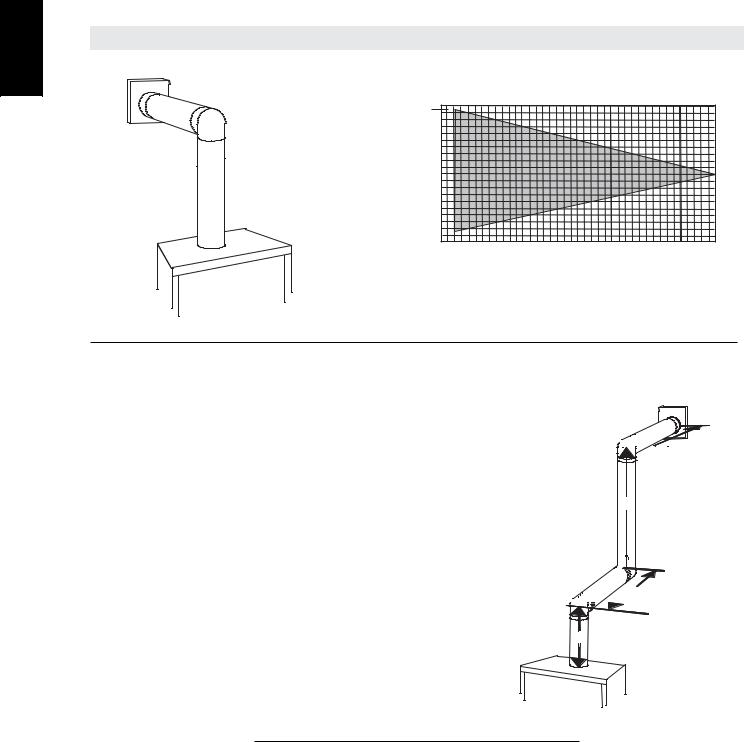
14
3.8HORIZONTAL TERMINATION
EN |
(HT) < (VT) |
|
|
|
|
|
|
|
|
|
Simple venting configuration (only one 90° elbow) |
|
See graph to determine the required vertical |
||||||||
|
|
|||||||||
|
|
|
rise VT for the required horizontal run HT. |
|||||||
|
|
40 (12.2) |
|
|
|
|
|
|
|
|
|
39 (11.9) |
|
|
|
|
|
|
|
|
|
|
REQUIRED |
30 (9.1) |
|
|
|
|
|
|
|
|
|
|
|
|
|
|
|
|
|
|
|
|
VERTICAL |
|
|
|
|
|
|
|
|
|
|
RISE IN FEET 20 (6.1) |
|
|
|
|
|
|
|
|
|
|
(METERS)VT |
|
|
|
|
|
|
|
|
|
|
|
10 (3.1) |
|
|
|
|
|
|
|
|
|
|
0 |
2.5 |
5 |
7.5 |
10 |
12.5 |
15 |
17.5 |
20 |
|
|
|
(0.8) |
(1.5) |
(2.3) |
(3.1) |
(3.8) |
(4.6) |
(5.3) |
(6.1) |
HORIZONTAL VENT RUN PLUS OFFSET IN
FEET (METERS) HT
The shaded area within the lines represents acceptable values for HT and VT
For vent configurations requiring more than one 90° elbow, the following formulas apply:
Formula 1: HT |
< VT |
|
|
Formula 2: HT |
+ VT |
< 40 feet (12.2m) |
|
Example: |
|
|
|
V1 |
= 3 FT (0.9m) |
|
|
V2 |
= 8 FT (2.4m) |
|
|
VT |
= V1 + V2= 3 FT (0.9m ) + 8 FT (2.4m) = 11 FT (3.4m) |
||
H1 |
= 2.5 FT (0.8m) |
|
|
H2 |
= 2 FT (0.6m) |
|
|
HR |
= H1 + H2 = 2.5 FT (0.8m) + 2 FT (0.6m) = 4.5 FT (1.4m) |
||
HO = .03 (three 90° elbows - 90°) = .03 (270° - 90°) = 5.4 FT (1.7m) HT = HR + HO = 4.5 FT (1.4m) + 5.4 FT (1.6m) = 9.9 FT (3m) HT + VT = 9.9 FT (3m) + 11 FT (3.4m) = 20.9 FT (6.4m)
90°



 H2
H2
V2
90°

 90°
90°




 H1
H1
Formula 1: |
HT |
< VT |
< 11 FT (3.4m) |
|
9.9 FT (3m) |
||
Formula 2: |
HT |
+ VT < 40 FT (12.2m) |
|
20.9 FT (6.4m) < 40 FT (12.2m)
Since both formulas are met, this vent confi guration is acceptable.
V1
16.1B
W415-2197 / 12.05.16
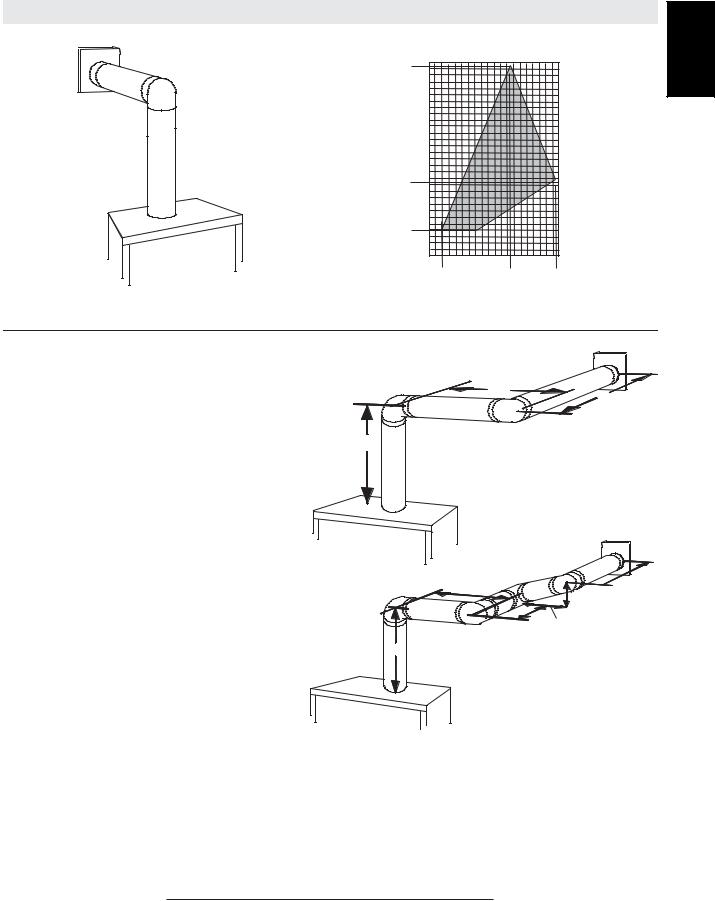
|
|
|
|
|
|
|
|
|
15 |
(HT) > (VT) |
|
|
|
|
|
|
|
|
|
Simple venting configuration (only one 90° elbow) |
See graph to determine the required vertical rise VT for the |
||||||||
|
|
required horizontal run H |
. |
EN |
|||||
|
|
150 (381) |
|
|
|
|
T |
|
|
|
|
150 (3810) |
|
|
|
|
|
|
|
|
|
147 |
|
|
|
|
|
|
|
|
|
147 |
|
|
|
|
|
|
|
|
|
(373.4) |
|
|
|
|
|
|
|
|
|
(3733.8) |
|
|
|
|
|
|
|
REQUIRED |
100 (2540) |
|
|
|
|
|
|
|
|
VERTICAL RISE |
|
|
|
|
|
|
|
||
|
|
100 (254) |
|
|
|
|
|
|
|
IN INCHES |
|
|
|
|
|
|
|
|
|
(CENTIMETERS) |
|
|
|
|
|
|
|
|
|
|
VT |
57 (144.8) |
|
|
|
|
|
|
|
|
|
57 (1447.8) |
|
|
|
|
|
|
|
|
|
50 (127) |
|
|
|
|
|
|
|
|
|
50 (1270) |
|
|
|
|
|
|
|
|
|
19191/21/2 |
|
|
|
|
|
|
|
|
|
(495(49..3)5) |
|
|
|
|
|
|
|
|
|
0 |
5 |
10 |
|
15 |
20 (6.1) |
|
|
|
|
0 |
5 |
10 |
|
15 |
20 (6.1) |
|
|
|
|
2 |
(1.5) |
(3.1) |
12.5 |
(4.6) |
19.5 |
|
|
|
|
2 |
(1.5) |
(3.1) |
(4.6) |
|
|
||
|
|
|
|
12.5 |
|
19.5 |
|
|
|
|
|
(0.6) |
|
|
(3.8) |
|
(5.9) |
|
|
|
|
(0.6) |
|
|
(3.8) |
|
(5.9) |
|
|
HORIZONTAL VENT RUN PLUS OFFSET IN FEET (METERS) HT |
|
||||||||
|
The shaded area within the lines represents acceptable |
|
|||||||
|
|
values for HT and VT |
|
|
|
||||
For vent configurations requiring more than one 90° elbow, the following formulas apply:
Formula 1: HT < 4.2 VT
Formula 2: HT + VT < 24.75 feet (7.5m)
Example:
V1 = VT = 6 FT (1.8m)
H1 = 3 FT (0.9m)
H2 = 5 FT (1.5m)
HR = H1 + H2 = 3FT (0.9m) + 5FT (1.5m) = 8 FT (2.4m)
HO = .03 (two 90° elbows - 90°) = .03 (180° - 90°) = 2.7FT (0.8m) HT = HR + HO = 8FT (2.4m) + 2.7FT (0.8m) = 10.7FT (3.3m)
HT + VT = 10.7FT (3.3m) + 6FT (1.8m) = 16.7FT (5.1m)
90° |
H1 |
V1 |
90° |
|
Formula 1: |
HT < 4.2 VT |
|
|
|
|
|||||
|
|
|
|
|
4.2 VT |
= 4.2FT (1.3m) x 6FT (1.8m) = 25.2FT (7.7m) |
|
|
|
90° |
|
|
|
|
|
10.7FT (3.3m) < 25.2FT (7.7m) |
|
H |
|
||
Formula 2: |
HT + VT |
< 24.75 FT (7.5m) |
90° |
1 |
90° |
|||||
|
|
|
|
|
16.7FT (5.1m) < 24.75 (7.5m) |
|
V2 |
|||
Since both formulas are met, this vent configuration is acceptable. |
|
|
|
H2 H3 |
||||||
Example: |
|
|
|
|
90° |
|||||
V |
|
= 4 FT (1.2m) |
|
V1 |
|
|||||
V21 |
= 1.5 FT (0.5m) |
|
|
|
|
|||||
V |
T |
= V + V |
2 |
= 4FT (1.2m) + 1.5FT (0.5m) = 5.5 FT (1.7m) |
|
|
|
|
||
|
1 |
|
|
|
|
|
|
|
||
H1 |
= 2 FT (0.6m) |
|
|
|
|
|
||||
H2 |
= 1 FT (0.3m) |
|
|
|
|
|
||||
H3 |
= 1 FT (0.3m) |
|
|
|
|
|
||||
H4 |
= 1.5 FT (0.5m) |
|
|
|
|
|
||||
HR |
= H1 |
+ H2 |
+ H3 + H4 = 2FT (0.6m) + 1FT (0.3m) + 1FT (0.3m) + 1.5FT (0.5m) = 5.5 FT (1.7m) |
|||||||
HO |
= .03 (four 90° elbows - 90°) = .03 (360° - 90°) = 8.1 FT (2.5m) |
|
|
|
|
|||||
HT |
= HR |
+ HO = 5.5 FT (1.7m) + 8.1 FT (2.5m) = 13.6 FT (4.2m) |
|
|
|
|
||||
HT |
+ VT |
= 13.6 FT (4.2m) + 5.5 FT (1.7m) = 19.1 FT (5.8m) |
|
|
|
|
||||
Formula 1: |
HT |
< 4.2 VT |
|
|
|
|
||||
|
|
|
|
|
|
4.2 VT = 4.2 FT (1.3m) x 5.5 FT(1.7m) = 23.1 FT (7m) |
|
|
|
|
|
|
|
|
|
13.6 FT (4.2m) < 23.1 FT (7m) |
|
|
|
|
|
Formula 2: |
HT |
+ VT < 24.75 FT (7.5m) |
|
|
|
|
||||
19.1FT (5.8m) < 24.75 FT (7.5m)
Since both formulas are met, this vent configuration is acceptable.
16.1_2B
H2
 H4
H4
W415-2197 / 12.05.16
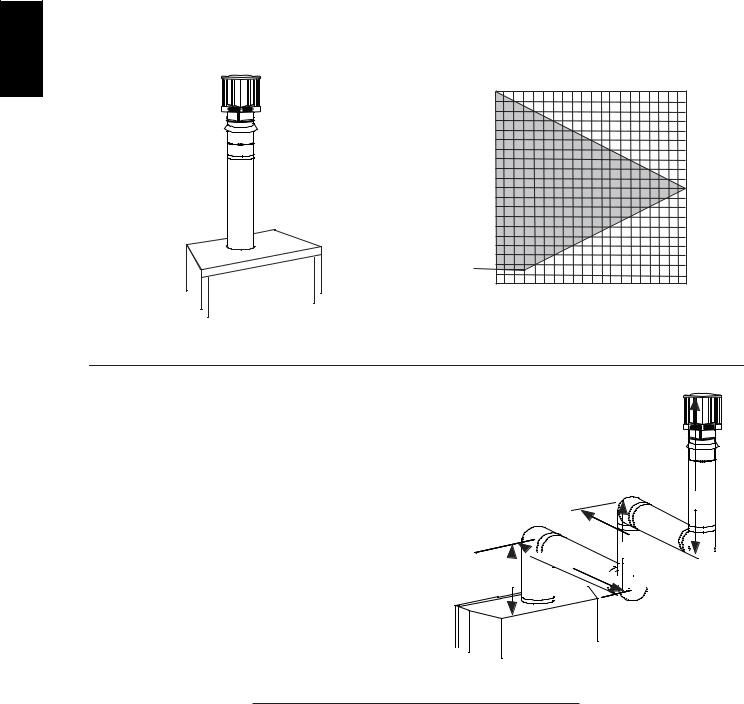
16
3.9VERTICAL TERMINATION
|
|
|
|
EN |
|
(HT) < (VT) |
|
Simple venting configurations. |
See graph to determine the required vertical rise VT for the |
||
|
|||
|
|
required horizontal run HT. |
|
40 (12.2) |
|
|
|
|
REQUIRED |
30 (9.1) |
|
|
|
|
|
|
|
|
|
|
VERTICAL |
|
|
|
|
|
RISE IN FEET |
20 (6.1) |
|
|
|
|
(METERS) VT |
|
|
|
|
|
|
10 (3.1) |
|
|
|
|
3 (0.9) |
|
|
|
|
|
|
0 |
5 |
10 |
15 |
20 |
|
|
(1.5) |
(3.1) |
(4.6) |
(6.1) |
HORIZONTAL VENT RUN PLUS OFFSET IN FEET (METERS) HT The shaded area within the lines represents acceptable
values for HT and VT
For vent configurations requiring one or more 90° elbows the following formulas apply:
Formula 1: HT < VT
Formula 2: HT + VT < 40 feet (12.2m)
Example:
V1 = 5 FT (1.5m)
V2 = 6 FT (1.8m)
V3 = 10 FT (3.1m)
VT = V1 + V2 + V3 = 5FT (1.5m) + 6FT (1.8m) + 10FT (3.1m) = 21FT (6.4m) H1 = 8 FT (2.4m)
H2 = 2.5 FT (0.8m)
HR = H1 + H2 = 8FT (2.4m) + 2.5FT (0.8m) = 10.5 FT (3.2m) HO = .03 (four 90° elbows - 90°)
= .03 (360° - 90°) = 8.1 FT (2.5m)
HT = HR + HO = 10.5FT (3.2m) + 8.1FT (2.5m) = 18.6FT (5.7m) HT + VT = 18.6FT (5.7m) + 21FT (6.4m) = 39.6FT (12.1m)
90°

 H1
H1 



 V1
V1 





Formula 1: |
HT |
< VT |
< 21FT (6.4m) |
|
|
18.6FT |
(5.7m) |
||
Formula 2: |
HT |
+ VT < 40 FT (12.19m) |
||
|
39.6FT |
(12.1m) |
< 40FT (12.2m) |
|
Since both formulas are met, this vent configuration is acceptable.
90°
V2H2
90°
18.1A
V3 |

 90°
90°
W415-2197 / 12.05.16
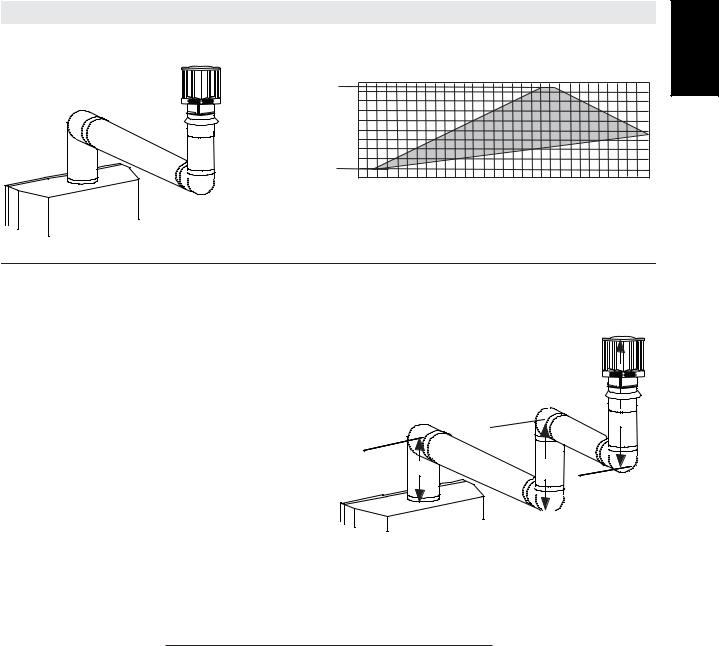
17
(HT) > (VT)
Simple venting configurations. |
See graph to determine the required vertical rise VT |
for the |
EN |
|
required horizontal run HT. |
|
|
20 (6.1) |
|
|
|
|
|
|
19 (5.8) |
|
|
|
|
|
|
|
REQUIRED |
|
|
|
|
|
|
|
VERTICAL |
|
|
|
|
|
|
|
RISE IN FEET |
10 (3.1) |
|
|
|
|
|
|
(METERS) VT |
|
|
|
|
|
|
|
|
3 (0.9) |
|
|
|
|
|
|
|
0 |
5 |
10 |
15 |
20 |
25 |
30 |
|
|
(1.5) |
(3.1) |
(4.6) |
(6.1) |
(7.6) |
(9.1) |
HORIZONTAL VENT RUN PLUS OFFSET IN FEET (METERS) HT
The shaded area within the lines represents acceptable values for HT and VT
For vent configurations requiring more than two 90° elbows the following formulas apply:
Formula 1: HT < 3VT
Formula 2: HT + VT < 40 feet (12.2m)
Example:
V1 = 2 FT (0.6m)
V2 = 1 FT (0.3m)
V3 = 1.5 FT (0.5m)
VT = V1+V2+V3= 2FT (0.6m) + 1FT (0.3m) + 1.5FT (0.5m) = 4.5FT (1.4m) H1 = 6 FT (1.8m)
H2 = 2 FT (0.6m)
HR = H1 + H2 = 6FT (1.8m) + 2FT (0.6m) = 8 FT (2.4m) HO = .03 (four 90° elbows - 90°)
= .03 (360° - 90°) = 8.1 FT (2.5m)
HT = HR + HO = 8FT (2.4m) + 8.1FT (2.5m) = 16.1FT (4.9m) HT + VT = 16.1FT (4.9m) + 4.5FT (1.4m) = 20.6 FT (6.3m)
Formula 1: |
HT |
< 3VT |
= 3FT (0.9m) x 4.5FT (1.4m) = 13.5FT (4.1m) |
|
|
3VT |
|
|
16.1FT (4.9m) > 13.5FT (4.1m) |
||
Since this formula is not met, this vent configuration is unacceptable. Formula 2: HT + VT < 40 feet (12.2m)
20.6FT (6.3m) < 40 (12.2m)
90°
90°
H2
V1 |
H1 |
V2 |

 90°
90°
V3 |
90° |
Since only formula 2 is met, this vent configuration is unacceptable and a new appliance location or vent configuration
will need to be established to satisfy both formulas.
18.1_2B
W415-2197 / 12.05.16
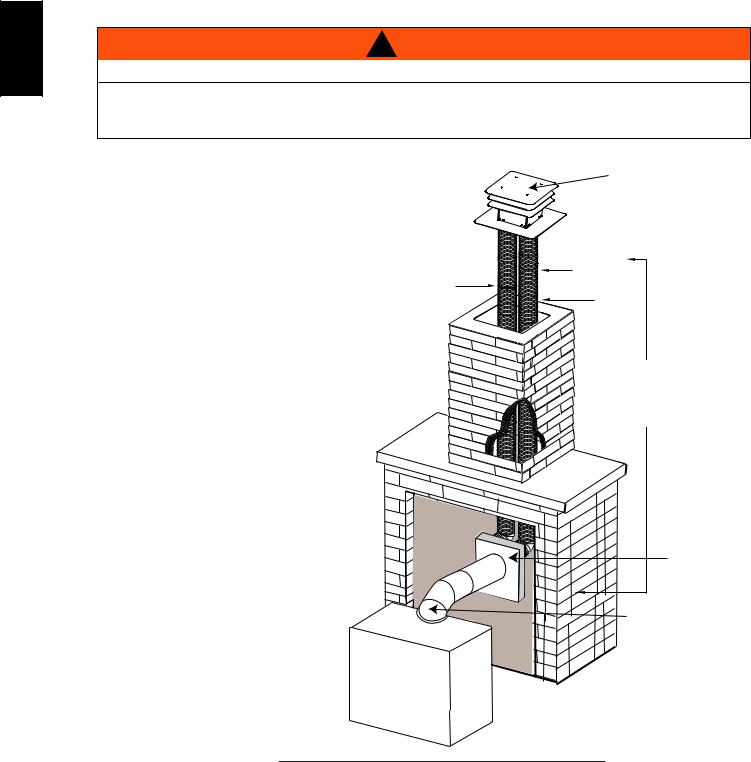
18
3.10CO-AXIAL TO CO-LINEAR VENTING
EN |
! WARNING |
|
|
RISK OF FIRE! |
|
CO-AXIAL TO CO-LINEAR VENTING CONFIGURATIONS MUST ONLY BE USED IN A |
||
NON-COMBUSTIBLE CHIMNEY OR ENCLOSURE. INSTALLATION IN A COMBUSTIBLE ENCLOSURE |
||
COULD RESULT IN A FIRE. |
|
|
This appliance is designed to be attached to a 3” (76.2mm) co-linear aluminum fl ex vent system running the |
||
full length of a masonry chimney. |
|
TERMINATION |
|
|
|
The fl ex liners accommodate any contours of a |
|
|
masonry chimney, however, it is necessary to keep |
|
|
the fl exible liners as straight as possible. The inlet air |
|
|
collar of the termination cap must be connected to |
|
|
the air intake fl ex liner and the exhaust collar must be |
EXHAUST |
|
connected to the exhaust fl exible liner. |
AIR |
FLUE |
|
INTAKE |
FLEX |
Both Simpson Duravent and Selkirk co-linear to |
LINER |
|
co-axial adaptors have been approved on this |
|
|
appliance (NOTE: A vent adaptor will be required |
|
|
directly off the appliance). |
|
* 40 FT (12.2m) |
Follow vent manufacturer’s installation instructions. |
||
|
|
MAX. |
Different manufacturer’s venting components must |
10 FT (3.1m) |
|
MIN |
||
not be combined. Once the preferred manufacturer’s |
||
|
||
appliance adaptor has been attached, the |
|
|
remainder of the system must be that of the |
|
|
same manufacturer. |
|
|
The only exception to this rule is to use Wolf |
|
|
Steel’s approved 3” (76.2mm) fl ex liner and |
|
|
co-linear termination. |
COAXIAL TO |
|
|
||
|
CO-LINEAR |
|
|
ADAPATOR |
|
|
APPLIANCE |
|
|
VENT ADAPTOR |
* Measured from appliance fl ue collar to termination fl ue collar
7.6B
W415-2197 / 12.05.16
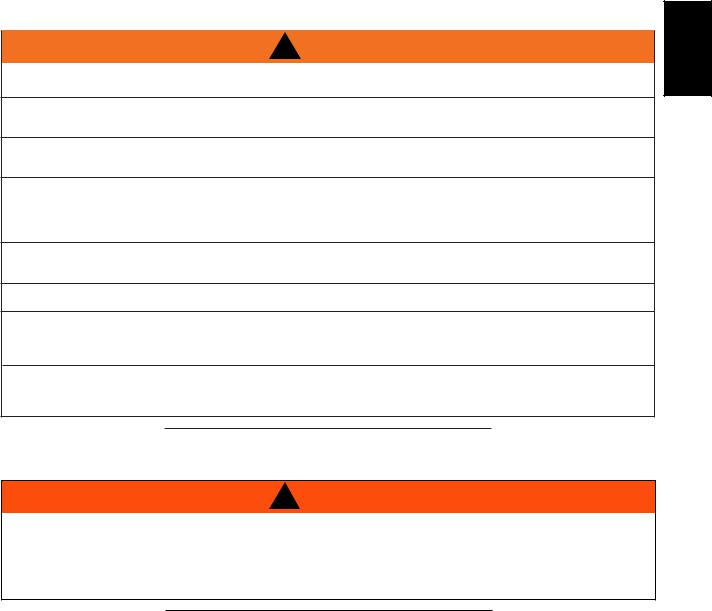
19
4.0 INSTALLATION
! WARNING |
EN |
ENSURE TO UNPACK ALL LOOSE MATERIALS FROM INSIDE THE FIREBOX PRIOR TO HOOKING UP
THE GAS AND ELECTRICAL SUPPLY.
IF YOUR APPLIANCE IS SUPPLIED WITH A REMOTE, ENSURE THE REMOTE RECEIVER IS IN THE “OFF” POSITION PRIOR TO HOOKING UP THE GAS AND ELECTRICAL SUPPLY TO THE APPLIANCE.
FOR SAFE AND PROPER OPERATION OF THE APPLIANCE, FOLLOW THE VENTING INSTRUCTIONS
EXACTLY.
ALL EXHAUST AND INTAKE VENT PIPE JOINTS MUST BE SEALED USING RED RTV HIGH TEMP SILICONE SEALANT (W573-0002) (NOT SUPPLIED) OR BLACK HIGH TEMP MILL PAC (W573-0007)
(NOT SUPPLIED) WITH THE EXCEPTION OF THE APPLIANCE EXHAUST FLUE COLLAR WHICH MUST
BE SEALED USING MILL PAC.
IF USING PIPE CLAMPS TO CONNECT VENT COMPONENTS, A MINIMUM OF 3 SCREWS MUST ALSO
BE USED TO ENSURE THE CONNECTION CANNOT SLIP OFF.
DO NOT CLAMP THE FLEXIBLE VENT PIPE.
RISK OF FIRE, EXPLOSION OR ASPHYXIATION. IMPROPER SUPPORT OF THE ENTIRE VENTING SYSTEM MAY ALLOW VENT TO SAG AND SEPARATE. USE VENT RUN SUPPORTS AND CONNECT VENT SECTIONS PER INSTALLATION INSTRUCTIONS.
RISK OF FIRE, DO NOT ALLOW LOOSE MATERIALS OR INSULATION TO TOUCH THE VENT PIPE. REMOVE INSULATION TO ALLOW FOR THE INSTALLATION OF THE ATTIC SHIELD AND TO MAINTAIN CLEARANCES TO COMBUSTIBLES.
68.2D
4.1WALL AND CEILING PROTECTION
! WARNING
DO NOT FILL THE SPACE BETWEEN THE VENT PIPE AND ENCLOSURE WITH ANY TYPE OF MATERIAL. DO NOT PACK INSULATION OR COMBUSTIBLES BETWEEN CEILING FIRESTOPS. ALWAYS MAINTAIN SPECIFIED CLEARANCES AROUND VENTING AND FIRESTOP SYSTEMS. INSTALL WALL SHIELDS AND FIRESTOPS AS SPECIFIED. FAILURE TO KEEP INSULATION OR OTHER MATERIALS AWAY FROM VENT PIPE MAY CAUSE FIRE.
70.1
For optimum performance it is recommended that all horizontal runs have a minimum of 1/4” (6mm) rise per foot using flexible venting. For safe and proper operation of the appliance, follow the venting instructions exactly.
W415-2197 / 12.05.16
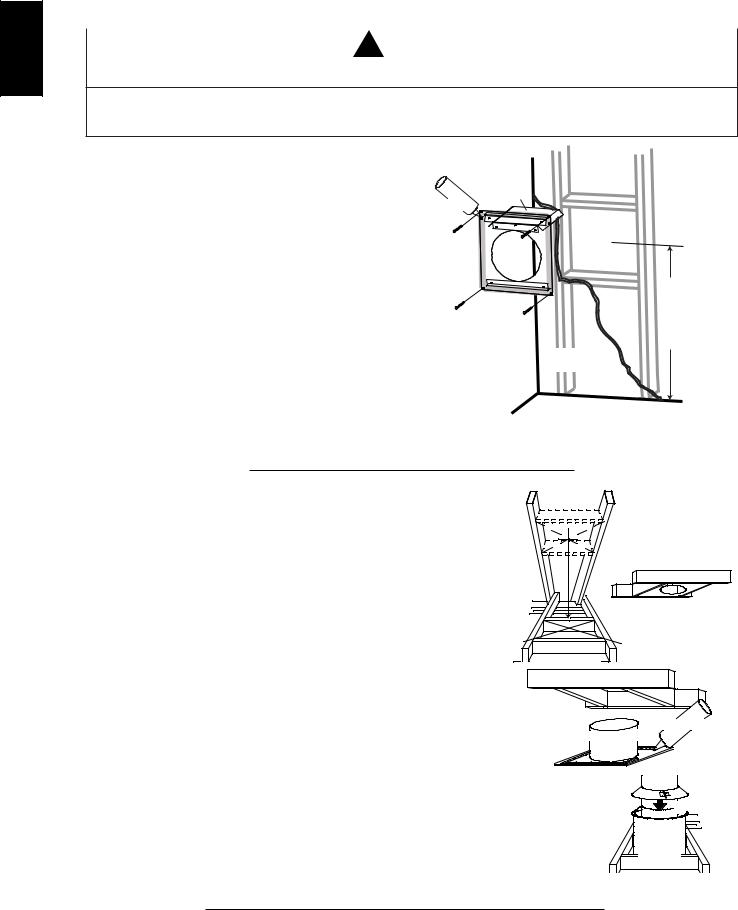
20
|
4.1.1 |
HORIZONTAL INSTALLATION |
||
|
||||
|
|
|
||
EN |
|
! WARNING |
||
THE FIRESTOP ASSEMBLY MUST BE INSTALLED WITH THE VENT SHIELD TO THE TOP.
TERMINALS MUST NOT BE RECESSED INTO A WALL OR SIDING MORE THAN THE DEPTH OF THE
RETURN FLANGE OF THE MOUNTING PLATE.
This application occurs when venting through an exterior wall. |
|
|
Having determined the correct height for the air terminal |
VENT |
|
location, cut and frame a hole in the exterior wall as |
||
SHIELD |
||
illustrated to accommodate the fi restop assembly. CAULKING |
||
Dry fi t the fi restop assembly before proceeding to |
|
|
ensure the brackets on the rear surface fi t to the |
|
|
inside surface of the horizontal framing. |
|
The length of the vent shield may be cut shorter for combustible walls that are less than 8 1/2” (215.9mm) thick but the vent shield must extend the full depth of the combustible wall.
A.Apply a bead of caulking (not supplied) around the corner edge of the inside surface of the fi restop assembly, fi t the fi restop assembly to the hole and secure using the 4 screws (supplied in your manual baggie).
FINISHING MATERIAL
DETERMINE THE CORRECT HEIGHT
B.Once the vent pipe is installed in its fi nal position, apply red RTV silicone (W573-0002) (not supplied) between the pipe and the fi restop.
|
|
20.2B |
|
4.1.2 |
VERTICAL INSTALLATION |
|
|
|
This application occurs when venting through a roof. Installation kits for |
|
|
|
various roof pitches are available from your authorized dealer / distributor. |
9 3/4” |
9 3/4” |
|
See accessories to order specific kits required. |
||
|
A. Determine the air terminal location, cut and frame a square opening as |
(248mm) |
(248mm) |
|
illustrated in the ceiling and the roof to provide the minimum 1" (25mm) |
|
|
|
clearance between the vent pipe and any combustible material. Try to |
FIRESTOP |
|
|
center the vent pipe location midway between two joists to prevent |
||
|
UNDERSIDE OF |
||
|
having to cut them. Use a plumb bob to line up the center of the |
||
|
JOIST |
||
|
openings. A vent pipe shield will prevent any materials such as |
||
|
|
|
|
|
insulation, from filling up the 1" (25mm) air space around the pipe. |
|
|
|
Nail headers between the joist for extra support. |
|
|
B. Apply a bead of caulking (not supplied) to the framework or to the |
|
|
|
Wolf Steel vent pipe shield plate or equivalent (in the case of a finished |
VENT PIPE CAULKING |
||
ceiling), and secure over the opening in the ceiling. A firestop must be placed |
|||
on the bottom of each framed opening in a roof or ceiling that the venting |
SHIELD |
|
|
system passes through. Apply a bead of caulking all around and place a |
|
VENT |
|
firestop spacer over the vent shield to restrict cold air from being drawn into the |
|
||
|
PIPE |
||
room or around the fireplace. Ensure that both spacer and shield maintain the required |
|||
COLLAR |
|||
clearance to combustibles. Once the vent pipe is installed in its final position, apply |
|||
VENT |
|||
Mill Pac sealant (W573-0007) (not supplied) or red RTV silicone (W573-0002) (not |
|||
supplied) between the pipe and the firestop assembly. |
|
PIPE |
|
C. In the attic, slide the vent pipe collar down to cover up the open end of the shield and |
SHIELD |
||
tighten. This will prevent any materials, such as insulation, from filling up the 1" (25mm) |
|
||
air space around the pipe. |
21.1B |
|
|
|
|
||
W415-2197 / 12.05.16 |
|
|
|
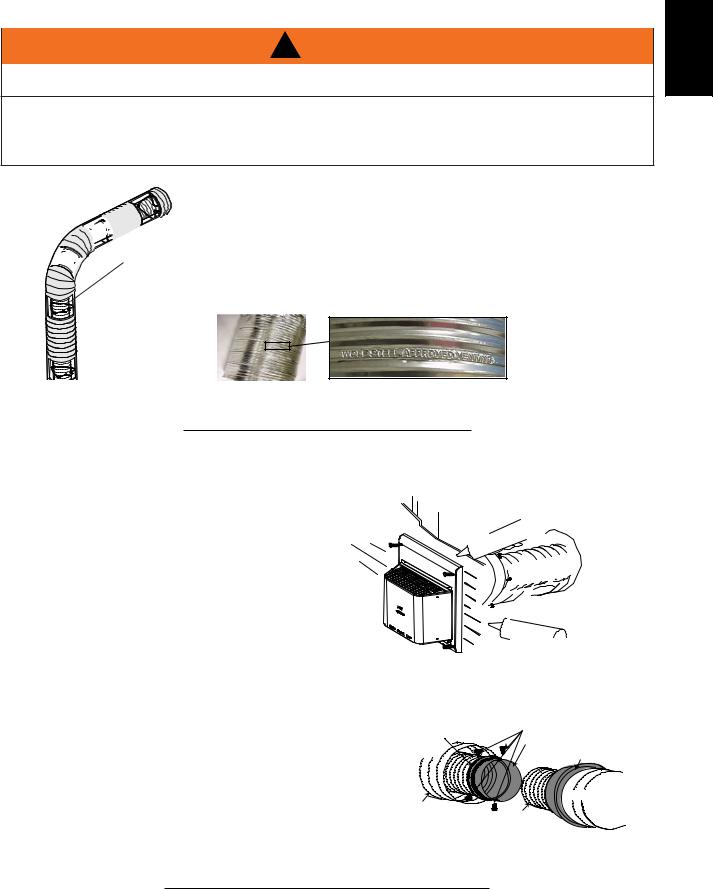
21
4.2USING FLEXIBLE VENT COMPONENTS
! WARNING |
EN |
DO NOT ALLOW THE INNER FLEX PIPE TO BUNCH UP ON HORIZONTAL OR VERTICAL RUNS AND ELBOWS.
KEEP IT PULLED TIGHT.
SPACERS ARE ATTACHED TO THE INNER FLEX PIPE AT PREDETERMINED INTERVALS TO MAINTAIN AN EVEN AIR GAP TO THE OUTER FLEX PIPE. THIS GAP IS REQUIRED FOR SAFE OPERATION. A SPACER IS REQUIRED AT THE START, MIDDLE AND END OF EACH ELBOW TO ENSURE THIS GAP IS MAINTAINED. THESE SPACERS MUST NOT BE REMOVED.
ELBOW 







 SPACERS
SPACERS
For safe and proper operation of the appliance, follow the venting instructions exactly.
All inner fl ex pipe and outer fl ex pipe joints may be sealed using high temperature red RTV silicone W573-0002 (not supplied) or the high temperature sealant W573-0007 Mill Pac (not supplied). However, the high temperature sealant W573-0007 Mill Pac (not supplied) must be used on the joint connecting the inner fl ex pipe and the exhaust fl ue collar.
Use only approved flexible vent pipe kits marked:
“Wolf Steel Approved Venting” as identified by the stamp only on the outer flex pipe.
22.1A
4.2.1 HORIZONTAL AIR TERMINAL INSTALLATION
A.Stretch the inner flex pipe to the required length taking into
account the additional length needed for the finished wall surface. Apply a heavy bead of the Mill Pac sealant (W573-0007) (not supplied) to the inner sleeve of
the air terminal. Slip the vent pipe a minimum of 2” (50.8mm) over the inner sleeve of the air terminal and secure with a minimum of 3 #8 screws.
CAULKING 

INNER |
FLEX |
|
|
PIPE |
|

 OUTER FLEX PIPE
OUTER FLEX PIPE
B. |
Using the outer flex pipe, slide over the outer |
|
2" (50.8mm) OVERLAP |
|
combustion air sleeve of the air terminal and secure with |
|
HIGH TEMPERATURE |
|
a minimum of 3 #8 screws. Seal using red RTV silicone |
#10x2" |
|
|
(W573-0002) (not supplied). |
SCREWS |
SEALANT |
C.Insert the vent pipes through the firestop maintaining the
required clearance to combustibles. Holding the air terminal |
|
#8 X 1/2” SELF DRILLING |
(lettering in an upright, readable position), secure to the |
HI-TEMP |
SCREWS |
exterior wall and make weather tight by sealing with |
INNER COUPLER |
|
caulking (not supplied). |
SEALANT |
OUTER COUPLER |
D. |
If more vent pipe needs to be used to reach the fireplace, |
|
OUTER |
|
couple them together as illustrated. The vent system must |
|
|
|
be supported approximately every 3 feet (0.9m) for both |
OUTER |
PIPE |
|
vertical and horizontal runs. Use noncombustible strapping |
FLEX PIPE |
INNER |
|
to maintain the minimum clearance to combustibles. |
|
FLEX PIPE |
The air terminal mounting plate may be recessed into the exterior wall or siding no greater than the depth of its return flange.
23.1C
W415-2197 / 12.05.16
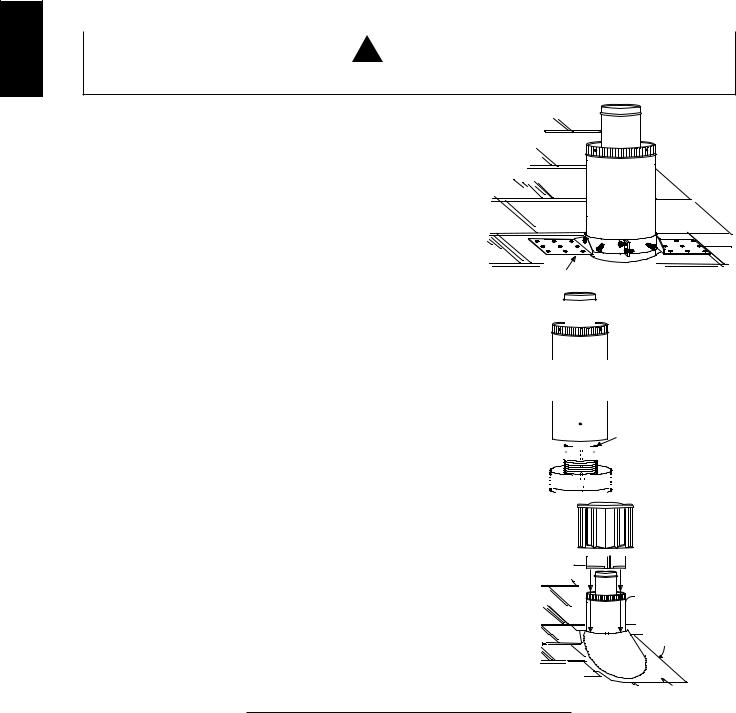
22
4.2.2 VERTICAL AIR TERMINAL INSTALLATION
EN |
|
! WARNING |
|
MAINTAIN A MINIMUM 2” (51mm) SPACE BETWEEN THE AIR INLET BASE AND THE STORM COLLAR.
A.Fasten the roof support to the roof using the screws provided. The roof support is optional. In this case the venting is to be adequately supported using either an alternate method suitable to the authority having jurisdiction or the optional roof support.
B.Stretch the inner fl ex pipe to the required length. Slip the
inner fl ex pipe a minimum of 2” (51mm) over the inner pipe of the air terminal connector and secure with a minimum of
3 #8 screws. Seal using a heavy bead of Mill Pac sealant (W573-0007) (not supplied).
C.Repeat using the outer fl ex pipe, using a heavy bead
of red RTV silicone (W573-0002) (not supplied) and a minimum of 3 #8 screws.
D.Thread the air terminal connector / vent pipe assembly down through the roof. The air terminal must be positioned vertically and plumb. Attach the air terminal connector to the roof support, ensuring that the top of the air terminal is 16” (40.6cm) above the highest point that it penetrates the roof.
E.Remove nails from the shingles, above and to the sides of the air terminal connector. Place the fl ashing over the air terminal connector leaving a min. 3/4” (19mm) of the air terminal connector showing above the top of the fl ashing. Slide the fl ashing underneath the sides and upper edge of the shingles. Ensure that the air terminal connector is properly centered within the fl ashing, giving a 3/4” (19mm) margin all around. Fasten to the roof. Do not nail through the lower portion of the fl ashing. Make weather-tight by sealing with caulking. Where possible, cover the sides and top edges of the
fl ashing with roofi ng material.
ROOF SUPPORT 
 INNER PIPE
INNER PIPE
MILL PAC
SEALANT (W572-0007)






 INNER FLEX PIPE
INNER FLEX PIPE







 OUTER FLEX PIPE
OUTER FLEX PIPE
F.Aligning the seams of the terminal and air terminal connector, place the terminal over the air terminal connector making sure the vent pipe goes into the hole in the terminal. Secure with the three screws provided.
G.Apply a heavy bead of weatherproof caulking 2” (51mm) above the fl ashing. Install the storm collar around the air terminal and slide down to the caulking. Tighten to ensure that a weather-tight seal between the air terminal and the collar is achieved.
H.If more vent pipe needs to be used to reach the appliance see “HORIZONTAL AIR TERMINAL INSTALLATION” section.
2” (51mm)


 AIR INLET
AIR INLET
BASE
CAULKING

 STORM COLLAR
STORM COLLAR
WEATHER SEALANT
FLASHING
24.1C
W415-2197 / 12.05.16
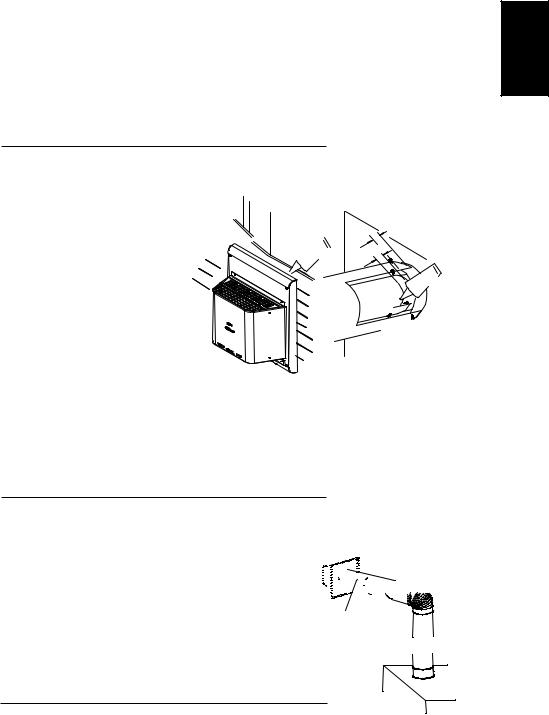
23
4.3USING RIGID VENT COMPONENTS
The vent system must be supported approximately every 3 feet (0.9m) for both vertical and horizontal runs.
Use Wolf Steel Ltd. support ring assembly or equivalent noncombustible strapping to maintain the minimum EN clearance to combustibles for both vertical and horizontal runs.
All inner exhaust and outer intake vent pipe joints may be sealed using either red high temperature silicone sealant (W573-0002) (not supplied) or black high temperature sealant W573-0007 Mill Pac (not supplied) with the exception of the appliance exhaust flue collar which must be sealed using Mill Pac.
|
|
|
25.1A |
|
|
4.3.1 HORIZONTAL AIR TERMINAL INSTALLATION |
|
|
|
||
A. |
Move the appliance into position. Measure the |
#10x2" |
|
1" (25.4mm) |
|
|
vent length required between terminal and |
|
|||
|
appliance taking into account the additional |
SCREWS |
|
OVERLAP |
|
|
length needed for the fi nished wall surface |
|
CAULKING |
|
|
|
and any 1¼” (31.8mm) overlaps between |
|
|
|
HI-TEMP |
|
venting components. |
|
|
INNER |
|
|
|
|
SEALANT |
||
B. |
Apply high temperature sealant W573-0007 Mill Pac |
OUTER |
RIGID |
|
|
RIGID |
PIPE |
|
|||
|
(not supplied) to the outer edge of the inner exhaust |
PIPE |
#8x1/2" |
||
|
fl ue collar of the appliance. Attach the fi rst inner |
|
|
SELF DRILLING |
|
|
rigid pipe component and secure using a minimum of |
|
SCREWS |
||
|
3 self tapping screws. Repeat using the outer rigid pipe |
|
|
|
|
C.Insert the vent pipes through the fi restop maintaining the required clearance to combustibles. Holding the air terminal (lettering in an upright, readable position), secure to the exterior wall and make weather tight by sealing with caulking (not supplied).
The air terminal mounting plate may be recessed into the exterior wall or siding no greater than the depth of the return flange.
26.1A
4.3.2 EXTENDED HORIZONTAL AIR TERMINAL INSTALLATION
A. Follow the instructions for "HORIZONTAL AIR TERMINAL INSTALLATIONS" section. AIR TERMINAL
B. Continue adding components alternating inner rigid pipe and outer rigid pipe. Ensure  that all inner rigid pipe and elbows have sufficient vent spacers attached and each component is sealed and securely fastened to the one prior. Attach the inner telescopic sleeve to the vent run. Repeat using the outer telescopic sleeve. Seal and secure as before. To facilitate completion, attach inner and outer couplers to the air terminal.
that all inner rigid pipe and elbows have sufficient vent spacers attached and each component is sealed and securely fastened to the one prior. Attach the inner telescopic sleeve to the vent run. Repeat using the outer telescopic sleeve. Seal and secure as before. To facilitate completion, attach inner and outer couplers to the air terminal.






 TELESCOPIC
TELESCOPIC 












 SLEEVE
SLEEVE
20" (508mm) |
COUPLER |
VENTING
C. Install the air terminal. See “HORIZONTAL AIR TERMINAL INSTALLATION” section.
48.1A
W415-2197 / 12.05.16
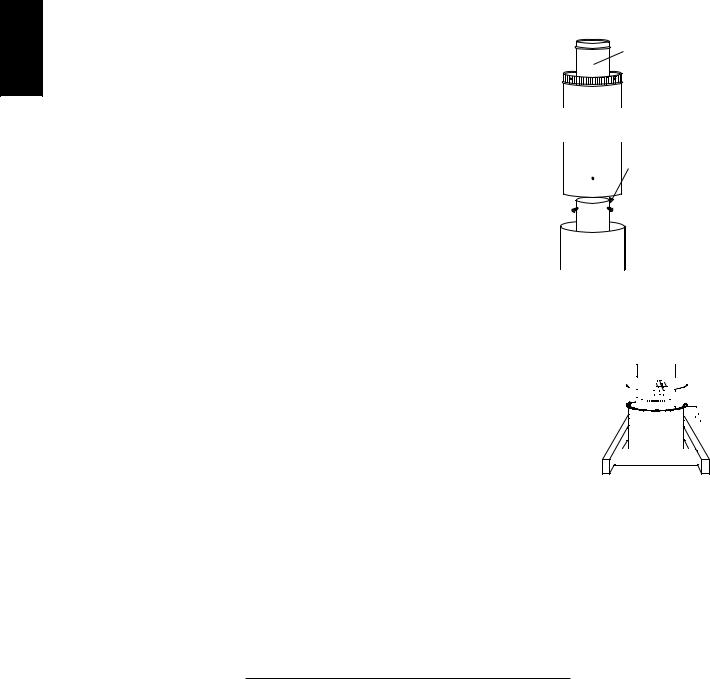
24
4.3.3 VERTICAL VENTING INSTALLATION
EN |
A. |
Move the appliance into position. |
|
B. |
Fasten the roof support to the roof using the screws provided. The |
||
|
|||
|
|
roof support is optional. In this case the venting is to be adequately |
|
|
|
supported using either an alternate method suitable to the authority |
|
|
|
||
|
|
having jurisdiction or the optional roof support. |
|
|
C. |
Apply high temperature sealant (not supplied) to the outer edge of |
|
|
|
the inner sleeve of the air terminal. Slip the inner coupler a minimum |
|
|
|
of 2" (51mm)over the sleeve and secure using a minimum of 3 |
|
|
|
screws. |
|
|
D. |
Apply high temperature sealant (not supplied) to the outer edge of |
|
|
|
the of the outside sleeve of the air terminal connector. Slip the outer |
|
|
|
coupler over the sleeve and secure as before. Trim the outer coupler |
|
|
|
even with the inner coupler end. |
INNER PIPE
AIR
TERMINAL
CONNECTOR
E.Thread the air terminal connector / vent pipe assembly down
through the roof support and attach, ensuring that a minimum 16" (40.6cm) of air terminal connector will penetrate the roof when fastened. If the attic space is tight, we recommend threading the Wolf Steel vent pipe collar or equivalent loosely onto the air terminal connector / vent pipe assembly as it is passed through the attic. The air terminal connector must be located vertically and plumb.
F.Remove nails from the shingles, above and to the sides of the air terminal connector. Place the fl ashing over the air terminal connector and slide it underneath the sides and upper edge of the shingles. Ensure that the air terminal connector is properly centered within the fl ashing, giving a 3/4" (19mm) margin all around. Fasten to the roof. Do NOT nail through the lower portion of the fl ashing. Make weather-tight by sealing with caulking. Where possible, cover the sides and top edges of the fl ashing with roofi ng material.
VENT 









 PIPE
PIPE 










 COLLAR
COLLAR
VENT

 PIPE
PIPE 

 SHIELD
SHIELD
G.Apply a heavy bead of waterproof caulking 2" (51mm) above the fl ashing.
Install the storm collar around the air terminal and slide down to the caulking. Tighten to ensure that a weather-tight seal between the air terminal connector and the collar is achieved.
H.Continue adding rigid venting sections, sealing and securing as above. Attach the inner collapsed telescopic sleeve to the last section of rigid piping. Secure with screws and seal. Repeat using the outer telescopic sleeve.
I.Run a bead of red RTV silicone (not supplied) around the outside of the inner exhaust fl ue collar on the appliance. Pull the telescopic sleeve a minimum of 2" (51mm) onto the collar. Secure with a mnimum of 3 screws. Repeat with the outer telescopic sleeve.
J.In the attic, slide the vent pipe collar down to cover up the open end of the shield and tighten. This will prevent any materials, such as insulation, from fi lling up the 1" (25mm) air space around the pipe.
27.2A
W415-2197 / 12.05.16
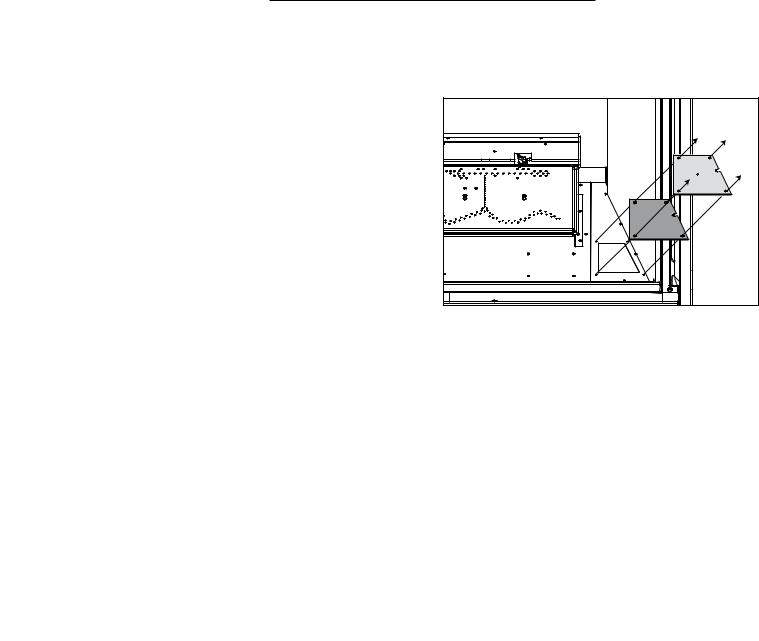
25
4.4 |
MOBILE HOME |
|
|
|
|
|
|
||
|
|
|
|
|
|
This appliance must be installed in accordance with the manufacturer’s instructions and the Manufactured |
|
EN |
|
|
Home Construction and Safety Standard, Title 24 CFR, Part 3280, in the United States or the Mobile Home |
|
|
|
|
Standard, CAN/CSA Z240 MH Series, in Canada. This appliance is only for use with the type(s) of gas |
|
|
|
|
indicated on the rating plate. |
|
|
|
|
|
|
|
|
|
Th s Mobile/Manufactur Home Lis ed appliance comes factory equipped with a mea s to secure the unit. Built |
|
|
|
|
Built in appliances are equipped with 1/4” (6.4mm) diameter holes located in the front left and right corners |
|
||
|
in appliances are equipped with 1/4” (6.4mm) diameter holes located in |
front left and right corners of the base. |
|
|
|
of the base, Use #10 hex head screws, inserted through the holes in the base to secure. For free standing |
|
||
|
Use #10 hex head screws, inserted through the holes in the base to secure. For free standing products contact |
|
||
|
products contact your local authorized dealer / distributor for the appropriate securing kit. For mobile home |
|
||
|
your local authorized dealer / distributor for the appropriate securing kit. For mobile home installations, |
|
||
|
installations, the appliance must be fastened in place. It is recommended that the appliance be secured in all |
|
||
|
the appliance must be fastened in place. It is recommended that the appliance be secured in all installations. |
|
||
|
installations. Always turn off the pilot and the fuel supply at the source, prior to moving the mobile home. Af- |
|
||
|
Always turn off the pilot and the fuel supply at the source, prior to moving the mobile home. After moving the |
|
||
|
ter moving the mobile home and prior to lighting the appliance, ensure that the logs are positioned correctly. |
|
||
|
mobile home and prior to lighting the appliance, ensure that the logs are positioned correctly. |
|
||
|
This appliance is certifi ed to be installed in an aftermarket permanently located, manufactured (mobile) |
|
|
|
|
home, where not prohibited by local codes. |
|
|
|
|
This appliance is only for use with the type of gas indicated on the rating plate. This appliance is not |
|
|
|
|
convertible for use with other gases, unless a certifi ed kit is used. |
|
|
|
|
Conversion Kits |
|
|
|
|
This appliance is fi eld convertible between Natural Gas (NG) and Propane (P). |
|
||
|
To convert from one gas to another consult your Authorized dealer/distributor. |
|
||
29.1B
4.5ACCESS PANEL FOR GAS LINE CONNECTION
A.Remove the 2 screws holding the grate in place.
B.Unscrew the 4 screws that hold the Access Panel to the firebox.
C.Remove the gasket (careful not to tear).
Access |
Panel |
Gasket |
W415-2197 / 12.05.16
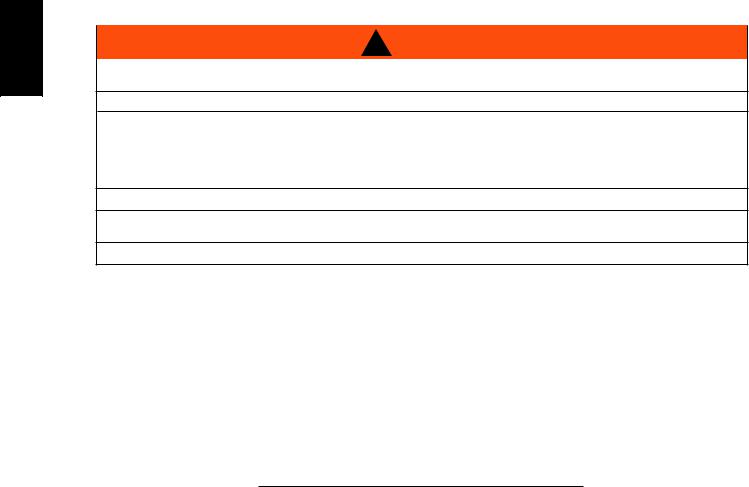
26
4.6GAS INSTALLATION
EN |
! WARNING |
RISK OF FIRE, EXPLOSION OR ASPHYXIATION. ENSURE THERE ARE NO IGNITION SOURCES SUCH AS
SPARKS OR OPEN FLAMES.
SUPPORT GAS CONTROL WHEN ATTACHING GAS SUPPLY PIPE TO PREVENT DAMAGING GAS LINE.
ALWAYS LIGHT THE PILOT WHETHER FOR THE FIRST TIME OR IF THE GAS SUPPLY HAS RUN OUT WITH THE GLASS DOOR OPENED OR REMOVED. PURGING OF THE GAS SUPPLY LINE SHOULD BE PERFORMED BY A QUALIFIED SERVICE TECHNICIAN. ASSURE THAT A CONTINUOUS GAS FLOW IS AT THE BURNER BEFORE CLOSING THE DOOR. ENSURE ADEQUATE VENTILATION. FOR GAS AND ELECTRICAL LOCATIONS, SEE “DIMENSIONS” SECTION.
ALL GAS CONNECTIONS MUST BE CONTAINED WITHIN THE APPLIANCE WHEN COMPLETE.
HIGH PRESSURE WILL DAMAGE VALVE. DISCONNECT GAS SUPPLY PIPING BEFORE TESTING GAS
LINE AT TEST PRESSURES ABOVE 1/2 PSIG.
VALVE SETTINGS HAVE BEEN FACTORY SET, DO NOT CHANGE.
Installation and servicing to be done by a qualifi ed installer.
•Move the appliance into position and secure.
•If equipped with a fl ex connector the appliance is designed to accept a 1/2” (13mm) gas supply. Without the connector it is designed to accept a 3/8” (9.5mm) gas supply. The appliance is equipped with a manual shut off valve to turn off the gas supply to the appliance.
•Connect the gas supply in accordance to local codes. In the absence of local codes, install to the current CAN/CSA-B149.1 Installation Code in Canada or to the current National Fuel Gas Code, ANSI Z223.1 / NFPA 54 in the United States.
•When fl exing any gas line, support the gas valve so that the lines are not bent or kinked.
•The gas line fl ex-connector should be installed to provide suffi cient movement for shifting the burner assembly on its side to aid with servicing components.
•Check for gas leaks by brushing on a soap and water solution. Do not use open flame.
30.1A
W415-2197 / 12.05.16

|
|
|
|
|
27 |
|
5.0 FRAMING |
|
|
||||
|
|
|||||
|
|
! WARNING |
|
EN |
||
|
|
RISK OF FIRE! |
|
|
||
|
IN ORDER TO AVOID THE POSSIBILITY OF EXPOSED INSULATION OR VAPOUR BARRIER COMING |
|
|
|||
|
IN CONTACT WITH THE APPLIANCE BODY, IT IS RECOMMENDED THAT THE WALLS OF THE |
|
|
|||
|
APPLIANCE ENCLOSURE BE “FINISHED” (IE: DRYWALL / SHEETROCK), AS YOU WOULD FINISH |
|
|
|||
|
ANY OTHER OUTSIDE WALL OF A HOME. THIS WILL ENSURE THAT CLEARANCE TO |
|
|
|||
|
COMBUSTIBLES IS MAINTAINED WITHIN THE CAVITY. |
|
|
|||
|
DO NOT NOTCH THE FRAMING AROUND THE APPLIANCE STAND-OFFS. FAILURE TO MAINTAIN |
|
|
|||
|
AIR SPACE CLEARANCE MAY CAUSE OVER HEATING AND FIRE. PREVENT CONTACT WITH |
|
|
|||
|
SAGGING OR LOOSE INSULATION OR FRAMING AND OTHER COMBUSTIBLE MATERIALS. BLOCK |
|
|
|||
|
OPENING INTO THE CHASE TO PREVENT ENTRY OF BLOWN-IN INSULATION. MAKE SURE |
|
|
|||
|
INSULATION AND OTHER MATERIALS ARE SECURED. |
|
|
|||
|
WHEN CONSTRUCTING THE ENCLOSURE ALLOW FOR FINISHING MATERIAL THICKNESS TO |
|
|
|||
|
MAINTAIN CLEARANCES. FRAMING OR FINISHING MATERIAL CLOSER THAN THE MINIMUMS |
|
|
|||
|
LISTED MUST BE CONSTRUCTED ENTIRELY OF NON-COMBUSTIBLE MATERIALS. MATERIALS |
|
|
|||
|
CONSISTING ENTIRELY OF STEEL, IRON, BRICK, TILE, CONCRETE, SLATE, GLASS OR PLASTERS, |
|
|
|||
|
OR ANY COMBINATION THEREOF ARE SUITABLE. MATERIALS THAT ARE REPORTED AS PASSING |
|
|
|||
|
ASTM E 136, STANDARD TEST METHOD FOR BEHAVIOUR OF MATERIALS IN A VERTICAL TUBE |
|
|
|||
|
FURNACE AT 1382°F (750°C) AND UL763 SHALL BE CONSIDERED NON-COMBUSTIBLE |
|
|
|||
|
|
MATERIALS. |
|
|
||
|
MINIMUM CLEARANCE TO COMBUSTIBLES MUST BE MAINTAINED OR A SERIOUS FIRE HAZARD |
|
|
|||
|
|
COULD RESULT. |
|
|
||
|
THE APPLIANCE REQUIRES A MINIMUM ENCLOSURE HEIGHT. MEASURE FROM THE APPLIANCE |
|
|
|||
|
|
BASE. |
|
|
||
|
IF STEEL STUD FRAMING KITS WITH CEMENT BOARD ARE PROVIDED, OR SPECIFIED IN THE |
|
|
|
||
|
INSTALLATION INSTRUCTIONS, THEY MUST BE INSTALLED. |
|
|
|||
|
IF SPECIFIED IN THE INSTALLATION INSTRUCTION FINISHING MUST BE DONE USING A NON- |
|
|
|||
|
COMBUSTIBLE MATERIAL SUCH AS NON-COMBUSTIBLE BOARD, CERAMIC TILE, MARBLE, ETC. |
|
|
|||
|
DO NOT USE WOOD OR DRYWALL. ANY FIRE RATED DRYWALL IS NOT ACCEPTABLE |
|
|
|||
|
|
|
71.1C |
|
|
|
|
|
|
|
|
||
It is best to frame your appliance after it is positioned and the vent system is installed. Frame to local building codes.
It is not necessary to install a hearth extension with this appliance.
When roughing in the appliance, raise the appliance to accommodate for the thickness of the finished floor materials, i.e. tile, carpeting, hard wood, which if not planned for will interfere with the opening of the lower access door and the installation of many decorative flashing accessories.
Combustible materials may be installed flush with the front of the appliance but must not cover any of the black face-areas of the appliance. Non-combustible material (brick, stone or ceramic tile) may protrude in these areas.
W415-2197 / 12.05.16
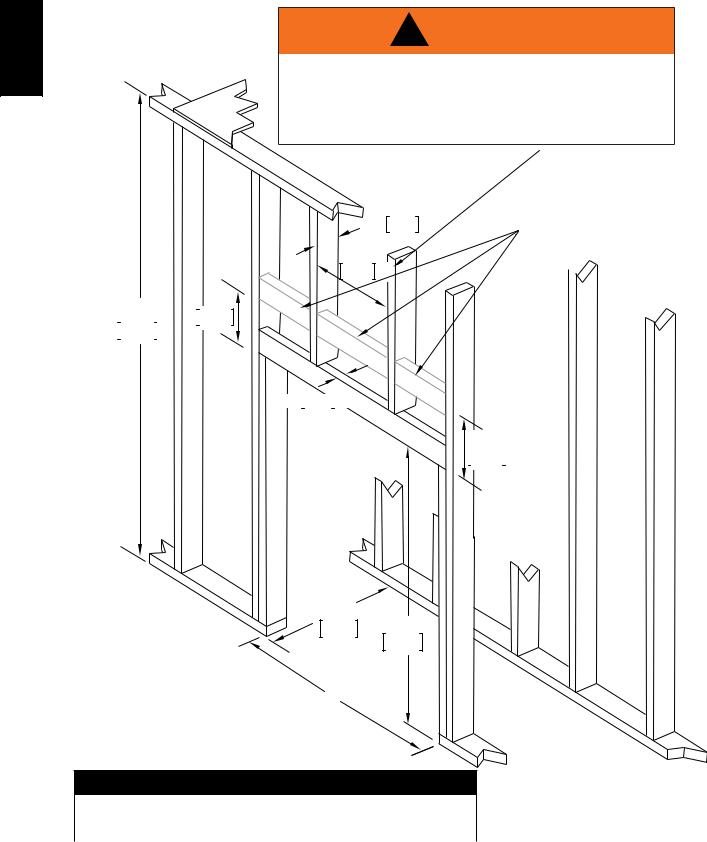
|
28 |
EN |
! WARNING |
DO NOT BUILD INTO THIS AREA - IT MUST BE LEFT
CLEAR TO PROVIDE ADEQUATE CLEARANCE FOR
THE VENT IN THIS 14” (35.6CM) WIDE AREA CENTERED
ALONG THE FRONT OF THE APPLIANCE. NO
COMBUSTIBLES ARE ALLOWED.
3 1/2” 89mm MAX |
NOTE:THREE BRACES ARE REQUIRED (AS |
14” |
NAILERS). |
|
|
35.6cm MIN |
|
|
70” |
|
4 3/4” |
||
|
|
121mm |
|||
|
177.8cm |
|
* |
|
|
|
|
|
|
||
1 1/2” 38mm
38mm MAX
MAX
6 1/2”  165mm
165mm
22 1/4” |
41 1/4” |
|
56.5cm ** |
||
104.8cm * |
A
FRAMING DIMENSIONS
Ref |
HD35-1 |
HD40-1 |
HD46-1 |
A |
35 3/4” (90.8cm) |
40 3/4” (103.5cm) |
46 3/4” (118.7cm) |
*Allow for finished floor and hearth thickness when setting these dimensions.
**When constructing the enclosure allow for finishing material thickness to maintain clearances.
W415-2197 / 12.05.16
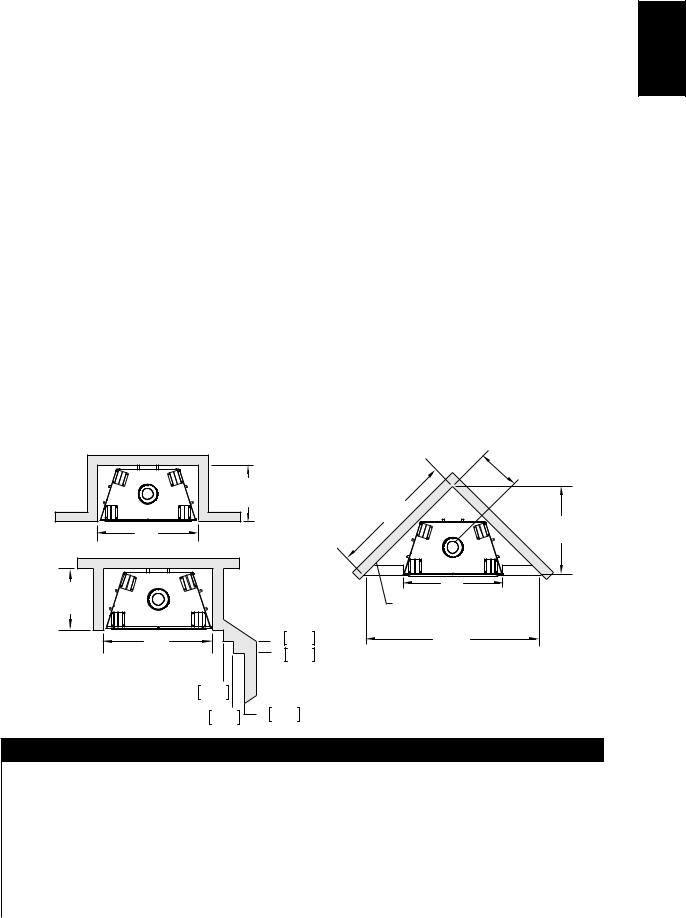
29
5.1MINIMUM CLEARANCE TO COMBUSTIBLES
COMBUSTIBLE FRAMING: |
|
|
EN |
Sides, back, bottom and top of the |
0" to stand offs |
|
|
appliance |
|
|
|
COMBUSTIBLE FINISHING: |
|
|
|
|
|
|
|
Sides, Bottom and Top |
1 1/4"(32mm) to sides, 0" to bottom, 6 1/2” (165mm) to top of the |
|
|
|
appliance |
|
|
Enclosure Top |
70" (177.8cm) from the bottom of the appliance |
|
|
Recessed Depth |
22 1/4" (56.5cm) |
|
|
Sides and bottom of the vent pipe |
1"* (25mm) |
|
|
Top of vent pipe |
2"* (51mm) |
|
|
Ceiling |
62" (157.5cm) from the bottom of the appliance |
|
|
*HORIZONTAL VENT SECTIONS: A minimum clearance of 1" (25mm) at the bottom and sides and 2" (51mm) at the top of the vent pipe in all horizontal runs to combustibles is required except for clearances in appliance enclosures. Horizontal vent sections within enclosures require a minimum clearance of 9” (229mm) at the top of the vent pipe. See “MINIMUM CLEARANCE TO COMBUSTIBLE ENCLOSURES” section. Use firestop spacer W010-1777 (supplied) where vent pipe penetrates combustible walls.
*VERTICAL VENT SECTIONS: A minimum clearance of 1" (25mm) all around the vent pipe on all vertical runs to combustibles is required except for clearances in appliance enclosures. Vertical vent sections within enclosures require a minimum clearance of 4" (102mm) to the sides of the vent pipe. See “MINIMUM CLEARANCE TO COMBUSTIBLE ENCLOSURES” section. Use firestop spacer W500-0292 (not supplied) where vent pipe penetrates combustible ceilings or floors.
OUTSIDE |
|
F |
|
|
|
CHASE |
|
|
|
|
|
A |
|
|
|
|
|
F |
|
INSIDE |
|
|
|
|
CHASE |
|
|
|
|
|
|
|
|
|
|
A |
|
|
|
2" |
51mm |
|
|
|
|
4" |
102mm |
2" |
51mm |
|
|
|
|
|
4" |
102mm |
6" |
152mm |
|
D
C
E
A |
BACKWALL OF CHASE / ENCLOSURE (INCLUDING ANY FINSIHING MATERIALS)
B
MINIMUM ENCLOSURE CLEARANCES
Ref |
HD35-1 |
HD40-1 |
HD46-1 |
A |
35 3/4" (90.8cm) |
40 3/4" (103.5cm) |
46 3/4" (118.7cm) |
B |
61 1/2" (156.2cm) |
66 1/2" (168.9cm) |
72 1/2" (184.2cm) |
C |
43 1/2" (110.5cm) |
47" (119.4cm) |
51 1/4" (130.2cm) |
D |
14 13/16" (37.6cm) |
16 9/16" (42.1cm) |
18 11/16" (47.5cm) |
E |
32 3/4" (83.2cm) |
35 1/4" (89.5cm) |
38 1/4" (97.2cm) |
F |
22 1/4" (56.5cm) |
22 1/4" (56.5cm) |
22 1/4" (56.5cm) |
W415-2197 / 12.05.16

30
5.2MINIMUM CLEARANCE TO COMBUSTIBLE ENCLOSURES
EN |
|
|
NON-COMBUSTIBLE |
||||
|
COMBUSTIBLE |
||||||
|
FIRESTOP SPACER |
|
|
|
|
|
BRICK |
|
|
|
|
|
|
||
|
|
|
|
|
|
|
|
|
|
|
|
||||
|
|
|
|
|
|
|
|
|
|
|
|
|
|
|
|
|
|
2” |
|
9” |
51mm |
|
229mm |
|
|
6” |
|
|
152mm |
1” |
6 1/2” |
|
25mm |
|
|
|
165mm |
|
|
70” |
NON-COMBUSTIBLE |
|
177.8cm |
57 1/2” |
|
MINIMUM |
MATERIAL |
146cm |
|
FRONT HOOD |
MINIMUM |
38” |
|
PLUS RISE* |
|
|
|
96.5cm |
|
|
33 3/4” |
|
|
85.7cm |
|
|
|
1” |
|
|
25mm |
|
0”IF NON-COMBUSTIBLE FINISHING IS USED SUCH AS BRICK AND STONE.
For temperature requirements, the enclosure space around and above the appliance must be left unobstructed. It is recommended that the enclosure be ventilated at the top and bottom to circulate the hot air.
* See “VENTING” section.
W415-2197 / 12.05.16
